Puerto Rico is a small island located in the Caribbean Sea, known for its stunning beaches, lush rainforests, and rich culture. However, what many people might not realize is that the island is also home to a diverse range of bird species.
Whether you’re a seasoned birder or simply a nature lover, Puerto Rico is an excellent destination for observing and learning about avian wildlife.
In this article, we will explore some of the most notable birds that inhabit the island, from vibrant parrots to elegant herons, and everything in between. Join us on a journey through the world of birds in Puerto Rico.
1. Phasianidae
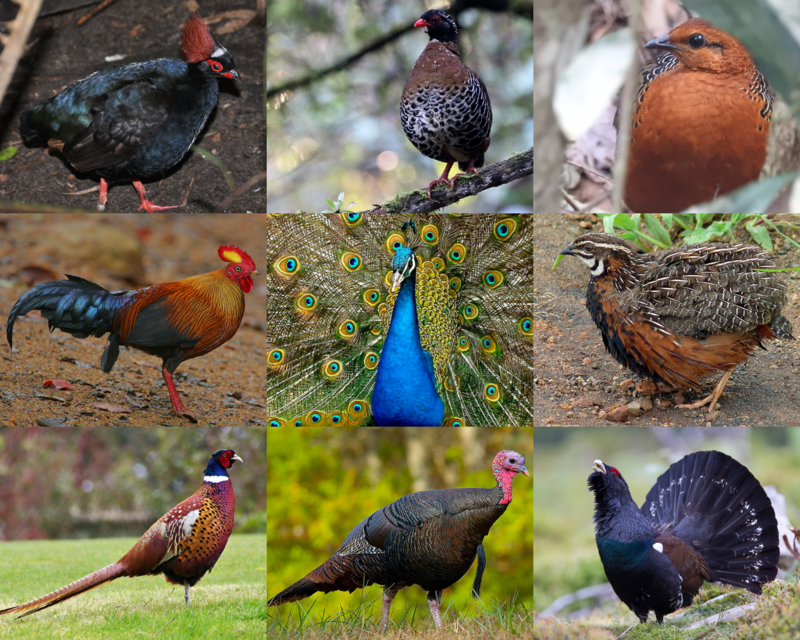
The Phasianidae family of birds is one that contains many popular gamebirds, with a total of 185 species divided across 54 genera.
These heavy ground-living birds include pheasants, partridges, junglefowl, chickens, and turkeys among others like Old World quail and peafowl.
This large family was formerly split into two subfamilies known as the Phasianinae and Perdicinae but this classification has since been changed to reflect more current scientific findings on them.
All these different types of birds have certain things in common such as their strong legs for scratching through leaves or soil looking for food items including insects, seeds, and other vegetation which makes up most of their diet.
They also all tend to be quite colorful in order to attract mates during breeding season when males will often display vibrant feathers or do dances around females in an attempt at courtship ritual displays.
The majority are monogamous creatures too although some may form short-term pair bonds before going off alone again once mating has taken place – either way.
There tends to be very little parental care given by adults after eggs have hatched so chicks need to fend for themselves right away.Scientific classification:
| Kingdom | Animalia |
| Phylum | Chordata |
| Class | Aves |
| Order | Galliformes |
| Superfamily | Phasianoidea |
| Family | Phasianidae Horsfield, 1821 |
Also Featured In: Most Common Birds in China, Turkey Birds You Should Know
2. Plovers

Plovers are a family of around 64-68 species of ground-dwelling birds, commonly found in open country such as fields, meadows and tundras.
They have short bills with webbed feet to help them forage through mud or shallow water.
Plover plumage is usually mottled brown though some species may have brighter colors on the head and wings.
These birds feed mainly on insects but can also eat small crustaceans and worms.
Plovers breed during springtime when they dig holes in sandy or pebbled beaches to lay their eggs which hatch after about 3 weeks incubation period.
They use distraction display behaviour by pretending an injury to the predators away from their nests if needed for protecting their young ones.Scientific classification:
| Kingdom | Animalia |
| Phylum | Chordata |
| Class | Aves |
| Order | Charadriiformes |
| Family | Charadriidae Leach, 1820 |
Also Featured In: Common Uzbekistan Birds, Most Common Romanian Birds
3. New World Quail
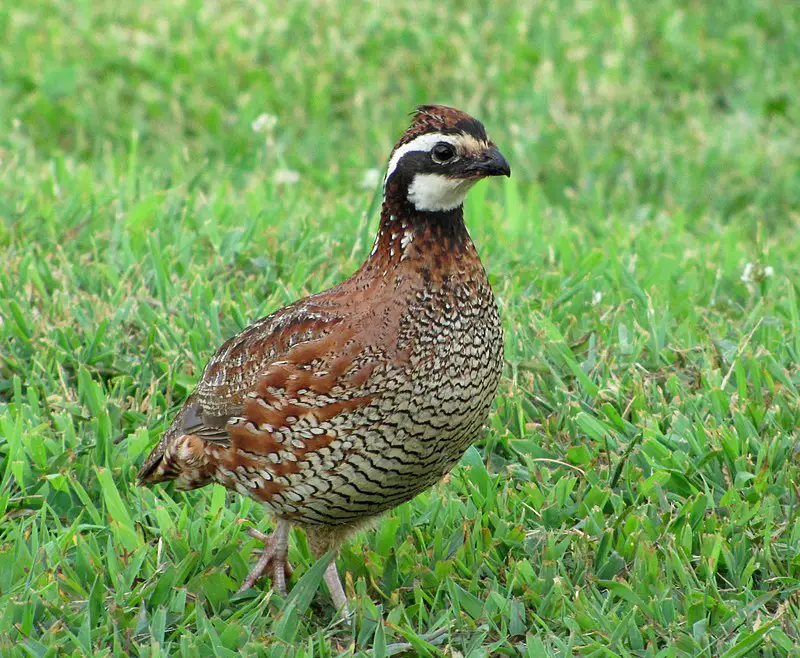
New World quail are small birds found in the Americas, from Canada to Brazil. They belong to their own family, Odontophoridae, and have similar appearance and habits as Old World quail which belong to a different family.
New World Quails come in various species such as California Quail and Bobwhite Quail.
These birds have adapted well to human presence due to availability of food resources like agricultural crops.
They also live close together where they form large flocks for safety against predators like foxes or hawks.
The males usually sport colorful feathers during mating season that helps them attract female mates while providing an amazing sight for us viewers.Scientific classification:
| Kingdom | Animalia |
| Phylum | Chordata |
| Class | Aves |
| Order | Galliformes |
| Superfamily | Phasianoidea |
| Family | Odontophoridae Gould, 1844 |
Also Featured In: Most Common United States Birds, Small Birds that Commonly Found in Ohio
4. Jacanas
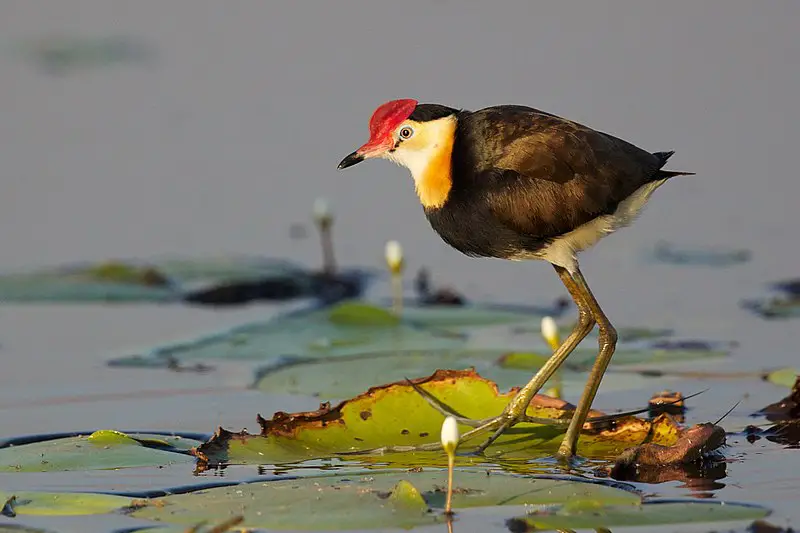
Jacanas are tropical waders belonging to the Jacanidae family. They have distinctive elongated toes and toenails which help them forage on floating or semi-emergent aquatic vegetation.
This adaptation gives them their nickname “Jesus birds” as they seem to be able to walk on water.
The female jacanas are also unique amongst bird species in that they take charge of nest building, incubation and caring for young while males perform courtship displays.
These unusual birds can be found throughout the world’s tropical regions where they inhabit wetlands such as swamps, marshes and shallow lakes with lily pads.
With a wide variety range due their special adaptations these beautiful creatures will surely continue living life at ease around our planet’s warmest waters.Scientific classification:
| Kingdom | Animalia |
| Phylum | Chordata |
| Class | Aves |
| Order | Charadriiformes |
| Suborder | Thinocori |
| Family | Jacanidae Stejneger, 1885 |
Also Featured In: Beautiful Brazilian Birds, Water Birds Live around Us
5. Northern Storm Petrels
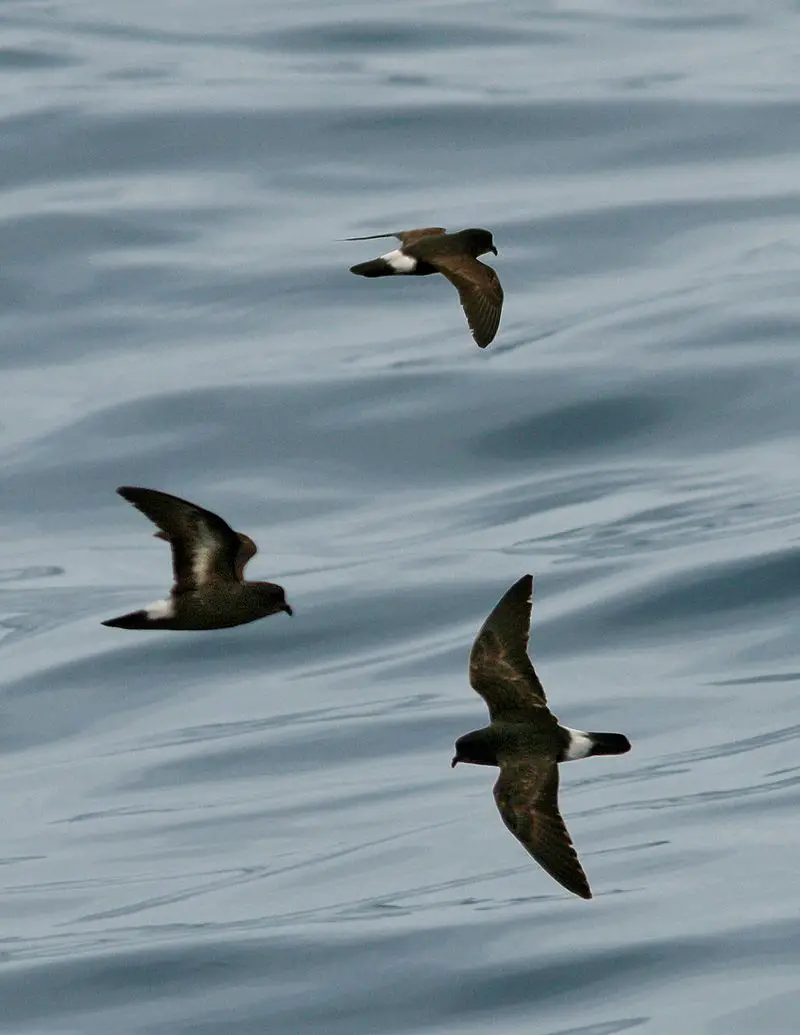
Northern storm petrels are one of the smallest seabirds, inhabiting oceans all over the world.
They have a unique ability to hover over water and pick planktonic crustaceans and small fish from the surface.
Northern storm petrels belong to the genus Hydrobates in family Hydrobatidae, part of Procellariiformes order.
This species was once lumped with austral storm petrel but recent studies show that they weren’t related closely which led them being split into two distinct species now.
These birds can be identified by their dark grey upperparts and wings along with white underparts when seen from afar while feeding on ocean’s surface.Scientific classification:
| Kingdom | Animalia |
| Phylum | Chordata |
| Class | Aves |
| Order | Procellariiformes |
| Family | Hydrobatidae Mathews, 1912 |
| Genus | Hydrobates F. Boie, 1822 |
Also Featured In: Birds You’ll Find in the Sea, Birds of Sweden
6. Cuckoos
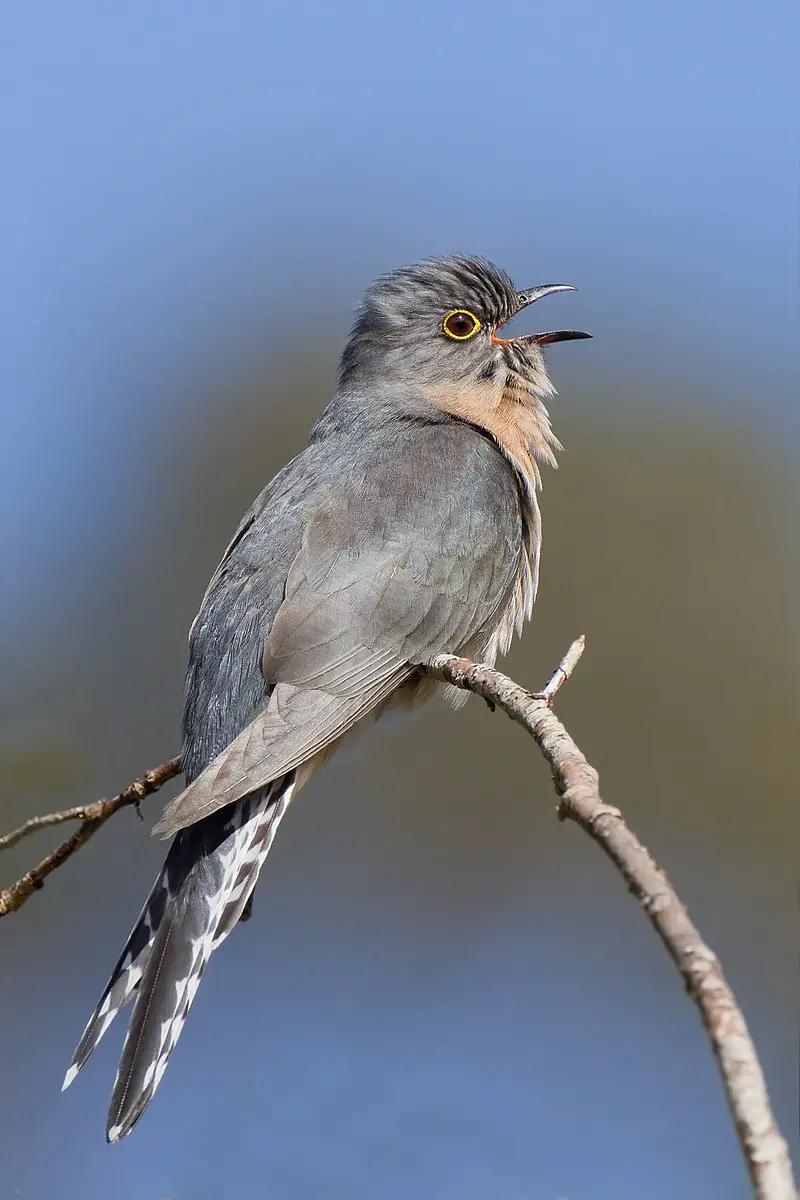
Cuckoos are fascinating birds belonging to the Cuculidae family, which is the only taxon in the order of Cuculiformes.
There are many different species within this family such as common or European cuckoo, roadrunners, koels, malkohas, couas and anis.
Some of these species may even be identified as separate families – Centropodidae and Crotophagidae respectively.
These birds have been known for their unique features such as loud calls heard consistently during certain times of day and night.
They also exhibit behavior like brood parasitism where they lay eggs in other nests so that their chicks can get more food from host parents than its own.
All these traits make them one-of-a-kind creatures worth admiring.Scientific classification:
| Kingdom | Animalia |
| Phylum | Chordata |
| Class | Aves |
| Clade | Otidimorphae |
| Order | Cuculiformes Wagler, 1830 |
| Family | Cuculidae Leach, 1820 |
Also Featured In: Most Common Types of Bangladeshi Birds, Birds You’ll Find in Moldova
7. Green Heron
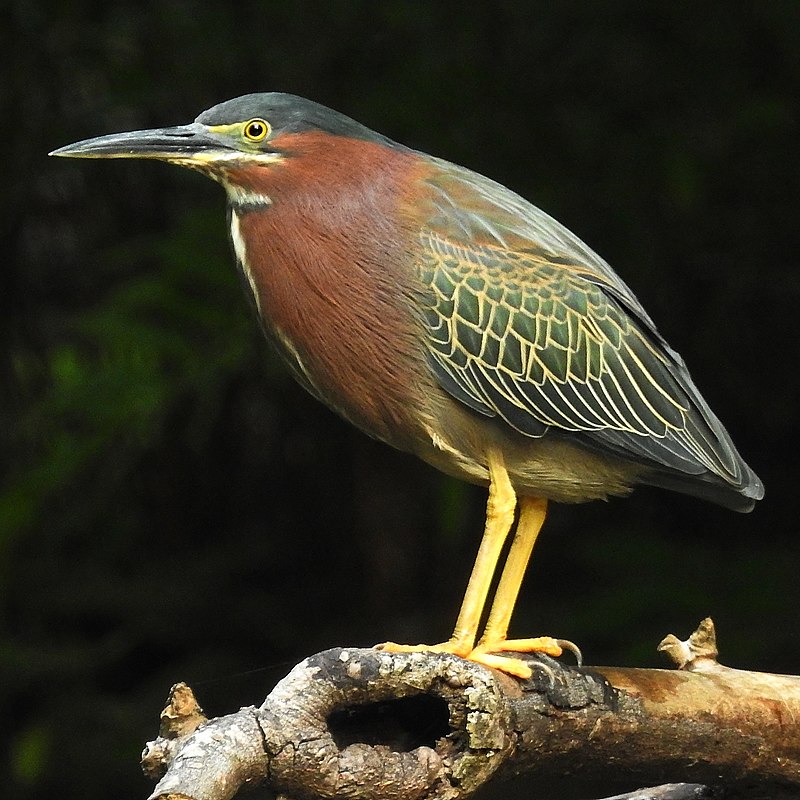
The Green Heron (Butorides virescens) is a small heron found throughout North and Central America.
It’s scientific name comes from Middle English ‘butor’ meaning bittern, combined with the Latin term for its distinctive greenish color – ‘virescens’.
For many years it was considered to be part of the same species as the Striated Heron (Butorides striata), commonly referred to as “green-backed herons”.
The nominate subspecies inhabits wetlands across much of this range, where they can be spotted stalking about in shallow water looking for fish or frogs on which to feed.
They are fascinating wading birds that have even been known to use tools such as sticks or baited lines when fishing.Scientific classification:
| Kingdom | Animalia |
| Phylum | Chordata |
| Class | Aves |
| Order | Pelecaniformes |
| Family | Ardeidae |
| Genus | Butorides |
| Species | B. virescens |
Also Featured In: Top Birds Found in Mexico, Common Southern Californian Birds
8. Brown Booby
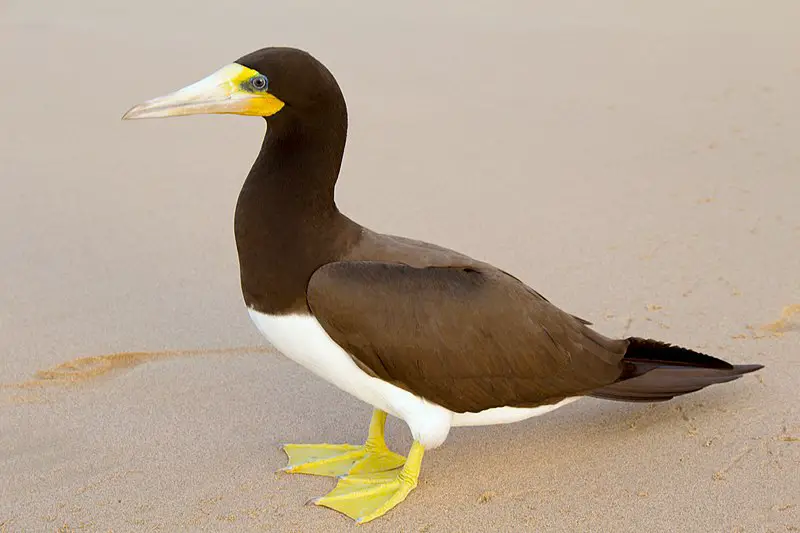
The Brown Booby is a large, seabird from the booby family Sulidae. It has a pantropical range and can be found in many areas of the world.
This bird lives in flocks and forages by plunging into shallow waters to catch small fish that are driven near the surface by predators or storms.
The brown booby is known for its short wings which make it highly maneuverable when hunting; this allows it to pursue prey quickly with sudden turns and dives.
Its diet also includes squid, crustaceans, eggs of other birds, as well as scraps from boats or ships they may come across while flying around coastlines.
They sometimes rest on floating objects during their long flights over open water between islands or continents.Scientific classification:
| Kingdom | Animalia |
| Phylum | Chordata |
| Class | Aves |
| Order | Suliformes |
| Family | Sulidae |
| Genus | Sula |
| Species | S. leucogaster |
Also Featured In: Egyptian Birds, Caribbean Birds
9. Procellariidae
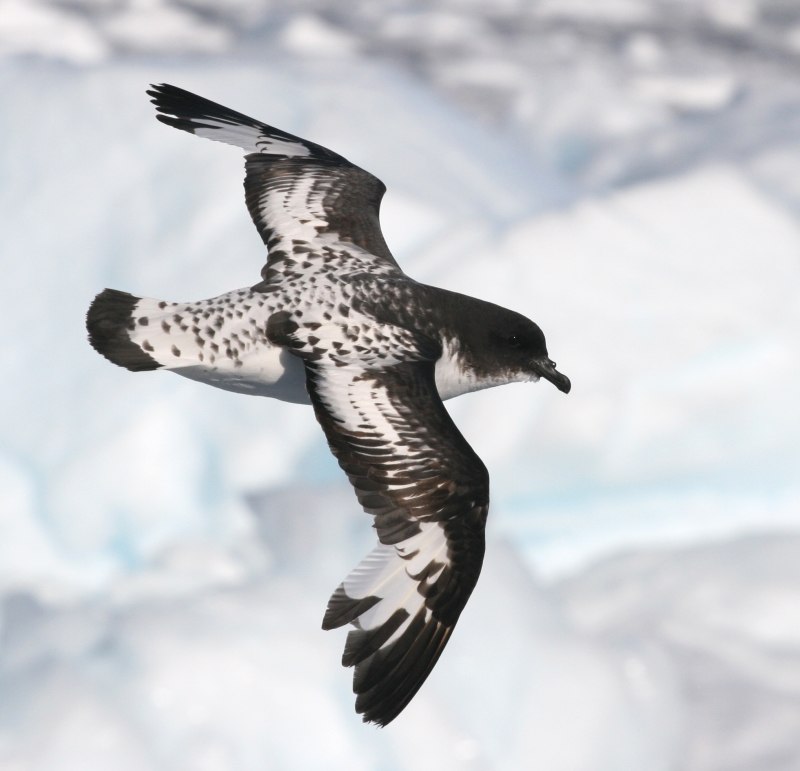
Procellariidae is a diverse family of seabirds belonging to the bird order Procellariiformes.
These birds are commonly referred to as tubenoses and include fulmarine petrels, gadfly petrels, diving petrels, prions, and shearwaters.
They range in size from the small storm-petrel which measures around 18cm long to the giant albatross which can reach up to 3 meters in length.
Generally found near oceans or coasts where they feed on fish as well as squid and other marine life depending on species.
Many procellariids will also nest inland during breeding season before returning back out at sea for most of their lives.
Their wings have specially adapted feathers that give them incredible gliding abilities allowing them literally fly with minimal effort over vast distances across oceanic regionsScientific classification:
| Kingdom | Animalia |
| Phylum | Chordata |
| Class | Aves |
| Order | Procellariiformes |
| Family | Procellariidae Leach, 1820 |
Also Featured In: Most common Birds in France, Bulgarian Birds
10. Smooth-Billed Ani
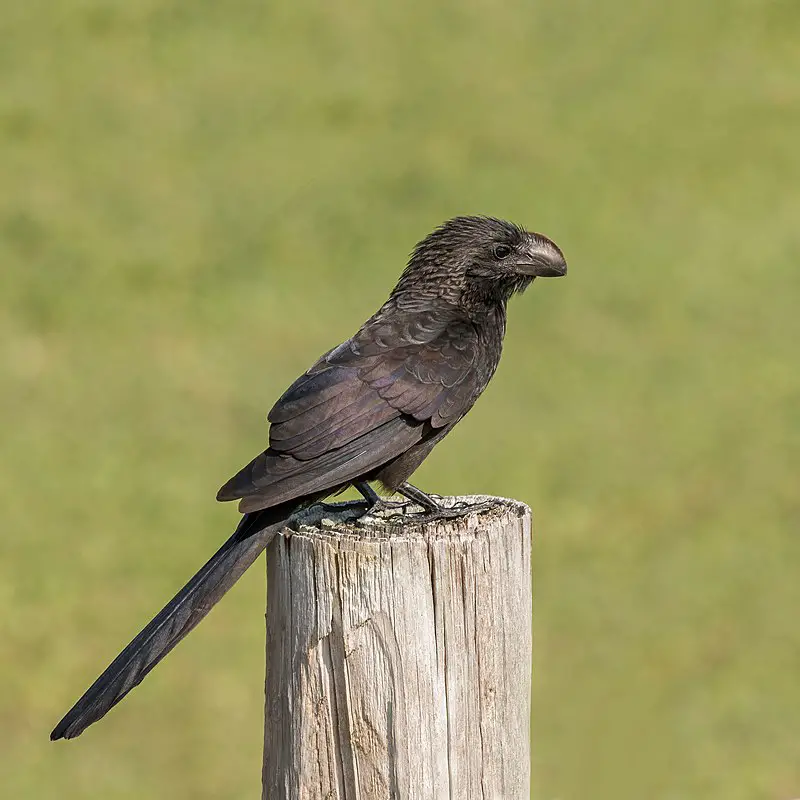
The Smooth-billed Ani is a species of bird in the cuckoo family, native to regions spanning from southern Florida and the Caribbean down through Central America, South America, and parts of Argentina.
They have even been introduced to Galapagos around 1960s where they may be impacting local wildlife due to their aggressive nature.
As its name suggests, these birds have smooth bills which are adapted for feeding on hard fruits or other items such as insects and lizards that it finds while scavenging around trees or ground level vegetation.
They usually form small flocks when out searching for food with males being slightly larger than females.
Overall this adaptable species is found in many habitats across its broad range but does best at low elevation open areas near water sources like marshes or swamps making them easier targets for human disturbance as well.Scientific classification:
| Kingdom | Animalia |
| Phylum | Chordata |
| Class | Aves |
| Order | Cuculiformes |
| Family | Cuculidae |
| Genus | Crotophaga |
| Species | C. ani |
Also Featured In: Common Birds in Colombia, Most Common Birds in South America Birds
11. Tyrant Flycatchers
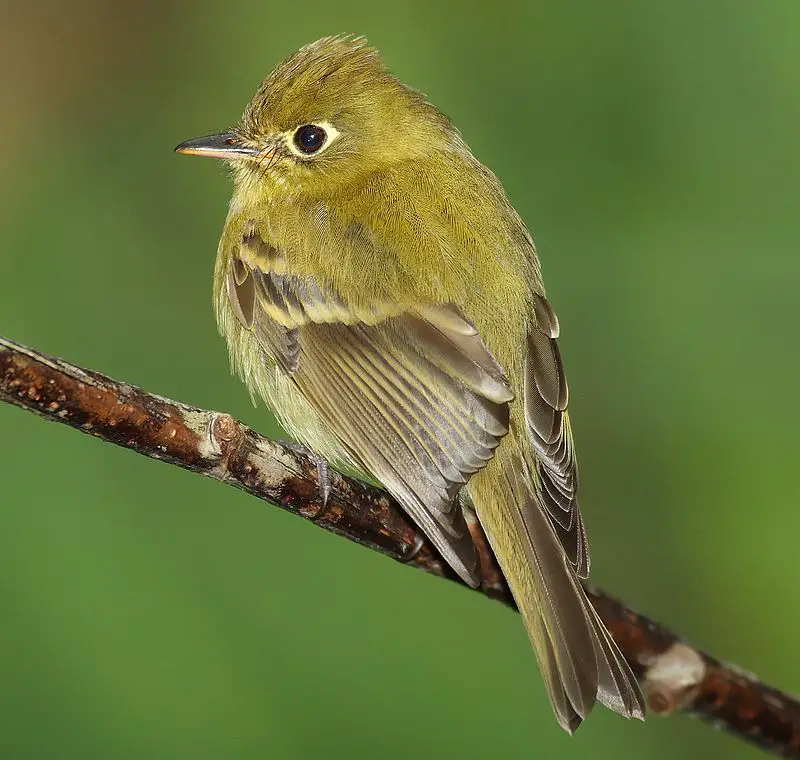
Tyrant flycatchers are a family of birds found in North and South America, containing over 400 species. These birds come in an array of shapes and sizes, with vibrant plumage to match.
They�re the most diverse avian family across all countries they inhabit except for the United States and Canada.
Their diet consists mainly of insects but also includes small reptiles or amphibians where available.
The behavior varies between each bird; some prefer open areas while others like dense forests as their habitat � many even migrate regularly.
Tyrant Flycatchers have adapted well to human presence thanks to the abundance of food sources that often accompany it � such as backyards, parks etc..
All things considered these incredible creatures are truly amazing.Scientific classification:
| Kingdom | Animalia |
| Phylum | Chordata |
| Class | Aves |
| Order | Passeriformes |
| Parvorder | Tyrannida |
| Family | Tyrannidae Vigors, 1825 |
Also Featured In: Birds of Argentina, Most Common Lake Birds
12. Austral Storm Petrels
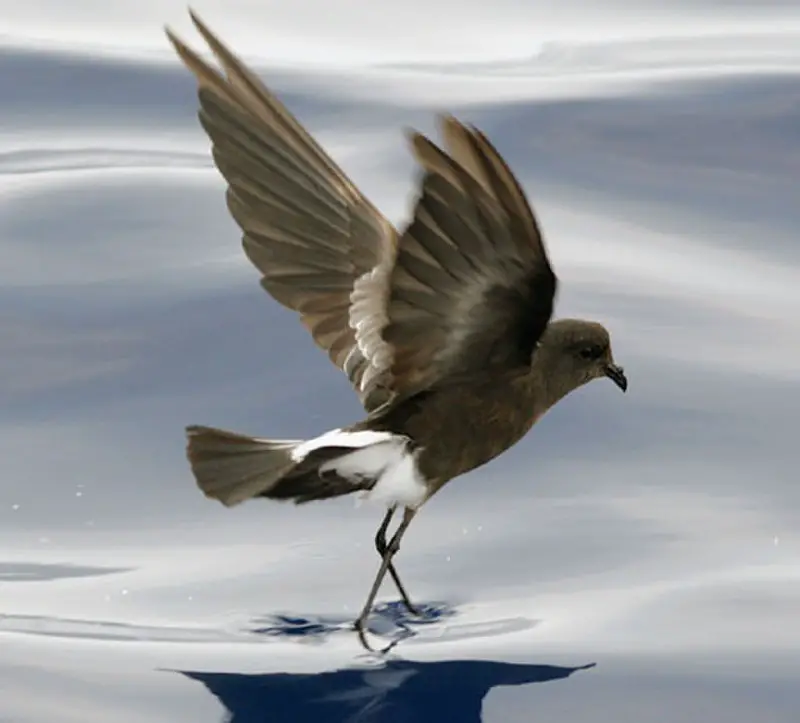
Austral Storm Petrels are the smallest of seabirds, belonging to the family Oceanitidae and order Procellariiformes.
They have a cosmopolitan distribution across all oceans, with their flight being fluttering and sometimes bat-like in appearance.
These birds feed on planktonic crustaceans as well as small fish that they pick from the surface while hovering over it.
Their plumage is mostly dark grey or blackish brown above; underparts may be white or mottled gray.
The feet vary between species but usually have pale yellow webs and claws which help them move easily through water when searching for food.
Austral storm petrels often make nests on remote islands where these birds can breed safely without any disturbances from humans during their nesting season.Scientific classification:
| Kingdom | Animalia |
| Phylum | Chordata |
| Class | Aves |
| Order | Procellariiformes |
| Family | Oceanitidae Forbes, 1881 |
Also Featured In: Birds of Morocco, Common Denmark Birds
13. Venezuelan Troupial
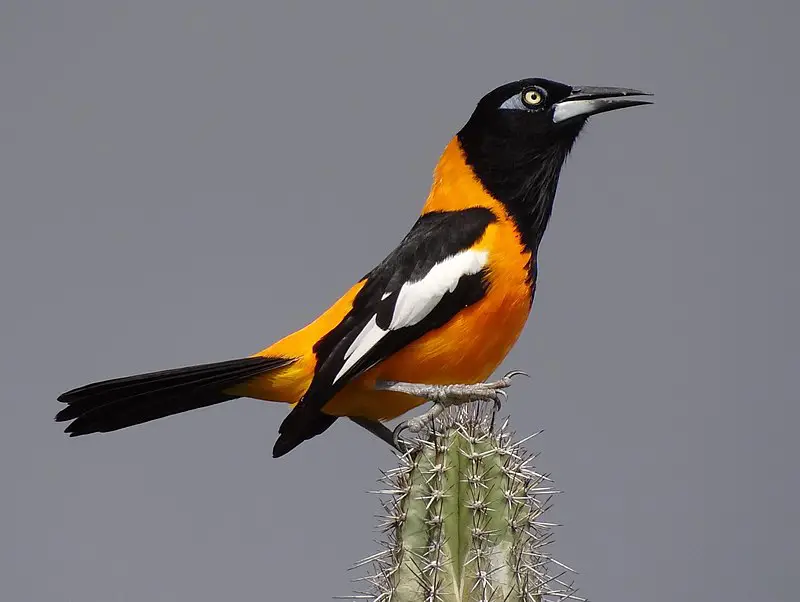
The Venezuelan troupial (Icterus icterus) is Venezuela’s national bird and can be found in Colombia, Venezuela and some Caribbean islands such as Aruba, Curaçao, Bonaire, Trinidad and Puerto Rico.
It was previously part of a superspecies known simply as the troupial with the orange-backed troupial and Campo troupial but has since been split off.
The name ‘troupial’ comes from French ‘toupiare’, which means “troop” due to their tendency to gather in flocks outside of breeding season.
They are medium sized birds with males being slightly larger than females – both have black bodies that contrast against a bright yellow head or crest.
Their wingspan averages at around 35cm long making them quite agile flyers when they migrate each year between November to April for warmer climates.Scientific classification:
| Kingdom | Animalia |
| Phylum | Chordata |
| Class | Aves |
| Order | Passeriformes |
| Family | Icteridae |
| Genus | Icterus |
| Species | I. icterus |
Also Featured In: Birds of Venezuela, Common Latin America Birds
14. Mimid
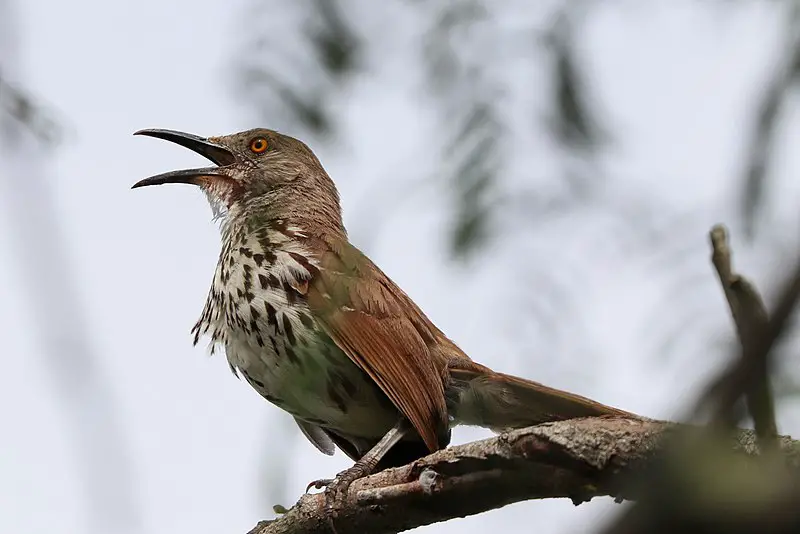
Mimid birds are a diverse family of passerines found in the New World. They have an impressive vocal range and many species excel at mimicking other bird songs, as well as noises from their environment.
Mimids can be identified by their flat heads with short crest feathers, long tails, large eyes and strong legs for hopping between branches.
These birds typically inhabit open woodlands or scrubland areas where they feed on insects such as beetles, caterpillars and grasshoppers.
Some species also supplement their diet with fruits or grains when available. While most do not migrate far during winter months some may undertake longer migrations to warmer climates if necessary to survive cold weather spells.
The wide variety of sounds these talented singers produce make them one of nature’s great musical performers.Scientific classification:
| Kingdom | Animalia |
| Phylum | Chordata |
| Class | Aves |
| Order | Passeriformes |
| Superfamily | Muscicapoidea |
| Family | Mimidae Bonaparte, 1853 |
Also Featured In: Most Beautiful Birds in Guatemala, Birds that Live in Newfoundland and Labrador
15. White-Cheeked Pintail
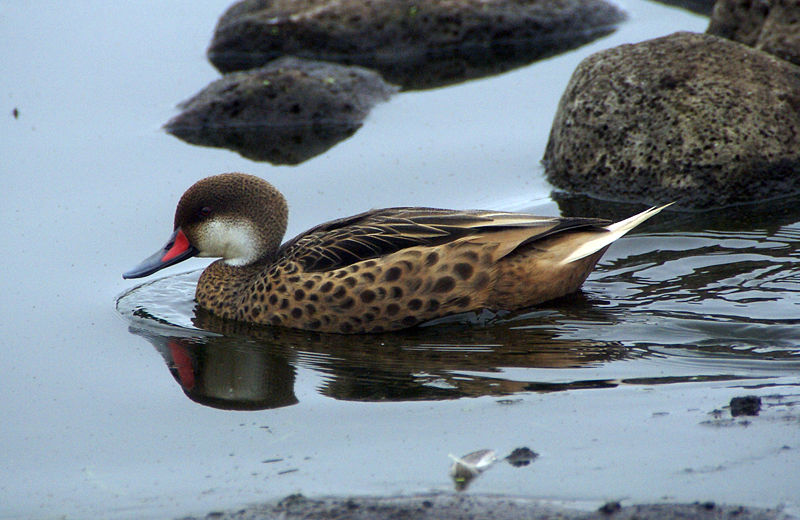
The white-cheeked pintail is a species of dabbling duck first described by Carl Linnaeus in 1758. This beautiful bird can be found mainly in the Caribbean, South America, and Galápagos Islands.
It prefers to inhabit brackish lakes or other waters with some salinity where it swims gracefully amongst its environment.
White-cheeked pintails have striking brown plumage on their back which contrasts beautifully against their white cheeks and bellies.
They also possess an elongated tail that aids them during flight as well as helping them attract potential mates while they are courting.
These birds feed primarily on aquatic invertebrates but may also consume small fish or plant material if available.
The conservation status of the white-cheeked pintail is currently considered “Least Concern” due to its wide distribution range and stable population numbers across much of its native habitat range.Scientific classification:
| Kingdom | Animalia |
| Phylum | Chordata |
| Class | Aves |
| Order | Anseriformes |
| Family | Anatidae |
| Genus | Anas |
| Species | A. bahamensis |
Also Featured In: Birds of Ecuador, Galapagos Birds You Should Know
16. Pin-Tailed Whydah
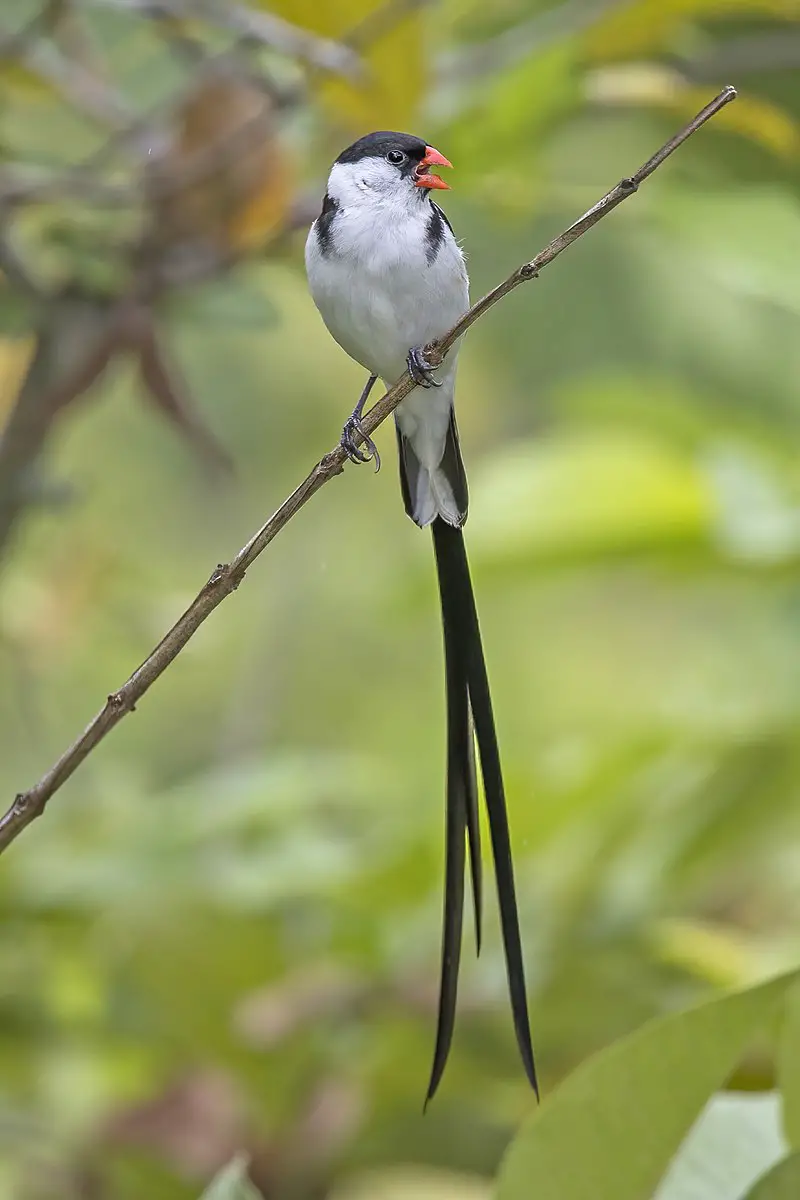
The Pin-tailed Whydah (Vidua macroura) is a small yet eye-catching songbird native to Africa, south of the Sahara Desert.
With breeding males sporting an impressive pennant-like tail, it measures in at 12–13 cm long and can be identified by its black plumage with white spots on wings and flanks.
It was first described by German naturalist Peter Simon Pallas back in 1764. The bird typically inhabits open savanna habitat where they feed mainly on grass seeds supplemented with insects during the rainy season.
During courtship displays, male birds will spread their tails while singing loudly from a perch or hover over females before mating takes place – making this one of nature’s most captivating spectacles.Scientific classification:
| Kingdom | Animalia |
| Phylum | Chordata |
| Class | Aves |
| Order | Passeriformes |
| Family | Viduidae |
| Genus | Vidua |
| Species | V. macroura |
Also Featured In: Birds of Senegal, Savanna Birds You Need to See
17. Viduidae
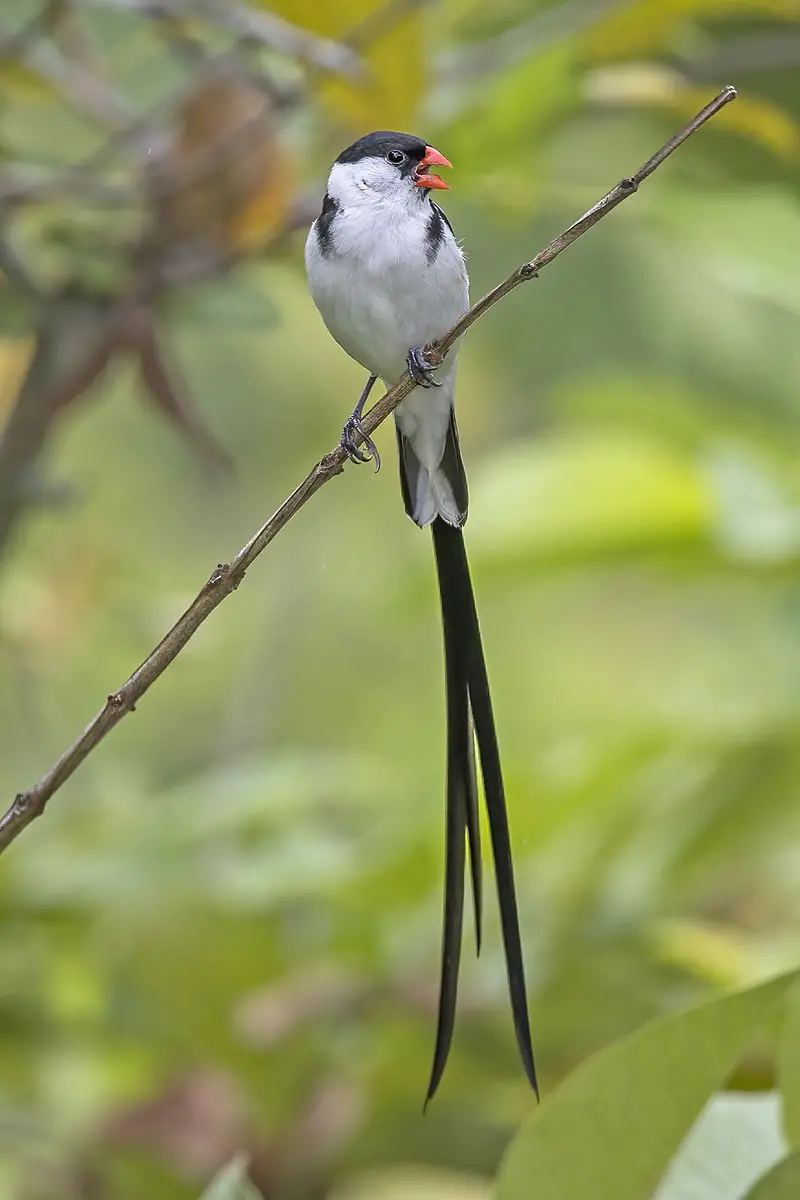
The Viduidae family of birds comprises the indigobirds, whydahs and cuckoo-finch. These species are small passerines native to Africa with black or indigo predominating in their plumage.
Male breeding whydah’s have distinctively long tails while all three types are obligate brood parasites which lay eggs in estrildid finch nests.
They feed mainly on insects found around grasses, shrubs and trees but also eat some fruits and seeds when available during colder seasons.
The female will fly off after laying her egg so as not to draw attention away from the host nest whilst allowing for a successful hatching rate of its own young within it.Scientific classification:
| Kingdom | Animalia |
| Phylum | Chordata |
| Class | Aves |
| Order | Passeriformes |
| Superfamily | Passeroidea |
| Family | Viduidae |
Also Featured In: Top Birds of Rwanda,
18. Greater Antillean Grackle
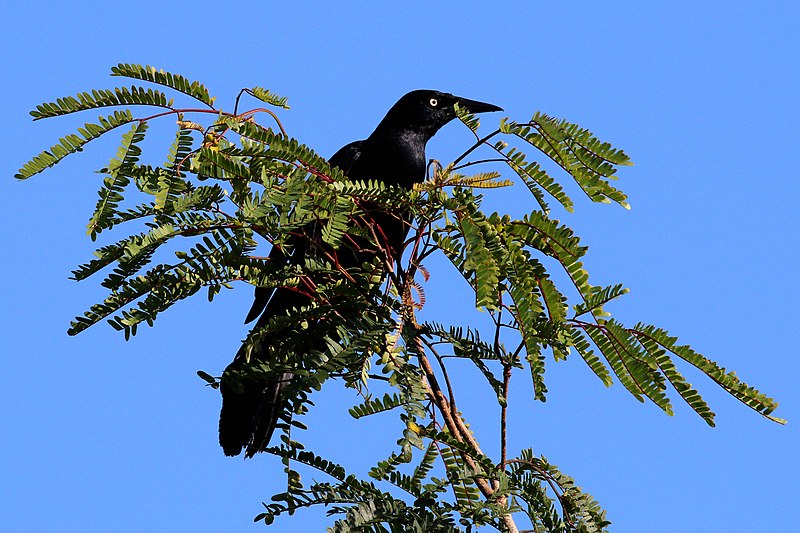
The Greater Antillean grackle is a large, sociable bird found in the Caribbean. It inhabits heavily populated areas and its call has been described as “kling-kling” or “chinchilin” in the Dominican Republic, “ching ching” in the Cayman Islands and ‘Chango’ by Puerto Rico locals.
They are mostly black with green iridescence on their upperparts, wings and tail feathers.
These birds feed mainly of insects but also consume fruits from trees like guava and mangoes.
Their diet supplements can include breadcrumbs from picnic tables that they often frequent near human dwellings for food scraps left behind by humans which allow them to survive even during dry seasons when other sources of food become scarce.Scientific classification:
| Kingdom | Animalia |
| Phylum | Chordata |
| Class | Aves |
| Order | Passeriformes |
| Family | Icteridae |
| Genus | Quiscalus |
| Species | Q. niger |
Also Featured In: Birds of Haiti, Beautiful Birds Found in Grand Cayman
19. Tody
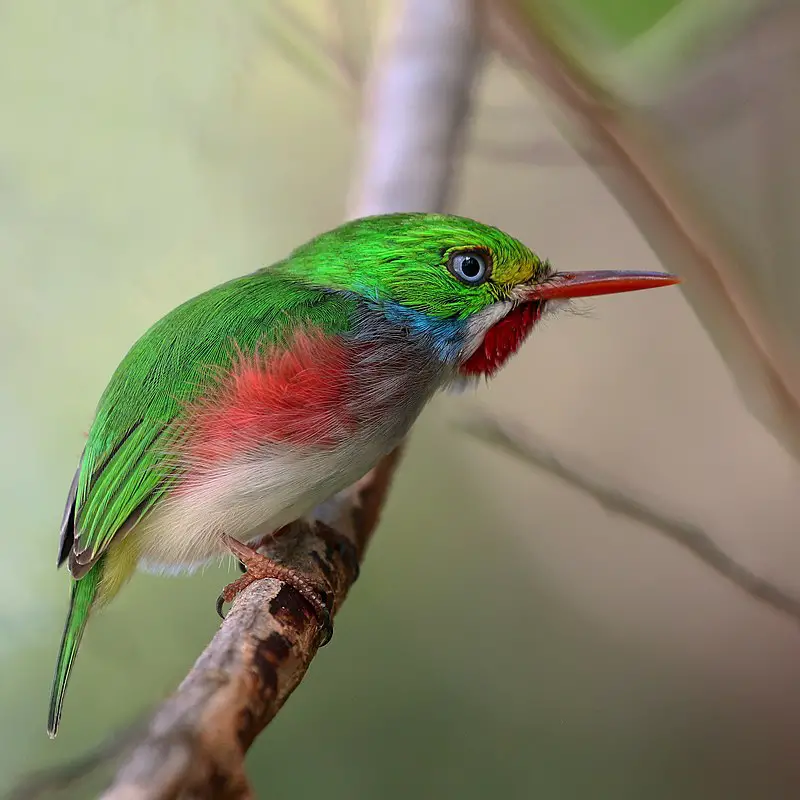
Tody birds are small yet stunningly beautiful Caribbean birds that belong to the Coraciiformes order, which also includes kingfishers, bee-eaters and rollers.
They make up the family Todidae with one living genus – Todus – and a fossilized genus called Palaeotodus.
The first classification of these birds was done by Mathurin Jacques Brisson in 1760 who placed them in their own distinct genus; they were originally part of Alcedo (the kingfisher).
These tiny beauties have bright green bodies with white bellies, black heads capped with red or orange feathers depending on species, short tails and yellow legs.
They live mainly in forests but will sometimes venture out into open meadows where they can be seen hunting insects like most other hummingbirds do.Scientific classification:
| Kingdom | Animalia |
| Phylum | Chordata |
| Class | Aves |
| Order | Coraciiformes |
| Family | Todidae Vigors, 1825 |
Also Featured In: Most Common Types of Birds Found in Cuba,
20. Red-Legged Thrush
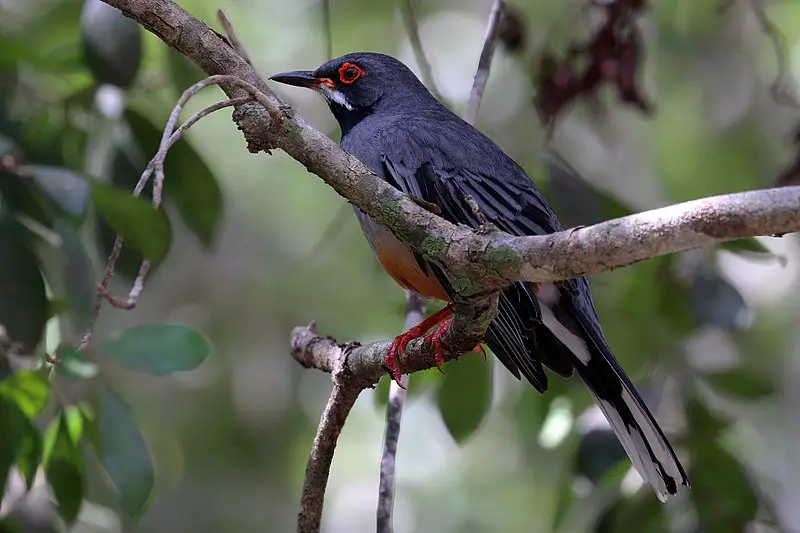
The Red-legged Thrush is a species of bird belonging to the Turdidae family, native to the Caribbean.
It can be found in places such as Bahamas, Cayman Islands and Puerto Rico where it goes by the name ‘Zorzal de patas coloradas’.
Unfortunately, this beautiful creature has been extirpated from Swan Island, Honduras. Its natural habitats are subtropical or tropical moist lowland forests and heavily degraded former forest areas.
This small thrush measures up to 22 cm in length with blackish upperparts while its underparts have reddish tinge on them which gives it an attractive appearance.
They mainly feed on fruits but also hunt for insects occasionally making it omnivorous in nature.Scientific classification:
| Kingdom | Animalia |
| Phylum | Chordata |
| Class | Aves |
| Order | Passeriformes |
| Family | Turdidae |
| Genus | Turdus |
| Species | T. plumbeus |
Also Featured In: Grand Bahama Birds,
21. Loggerhead Kingbird
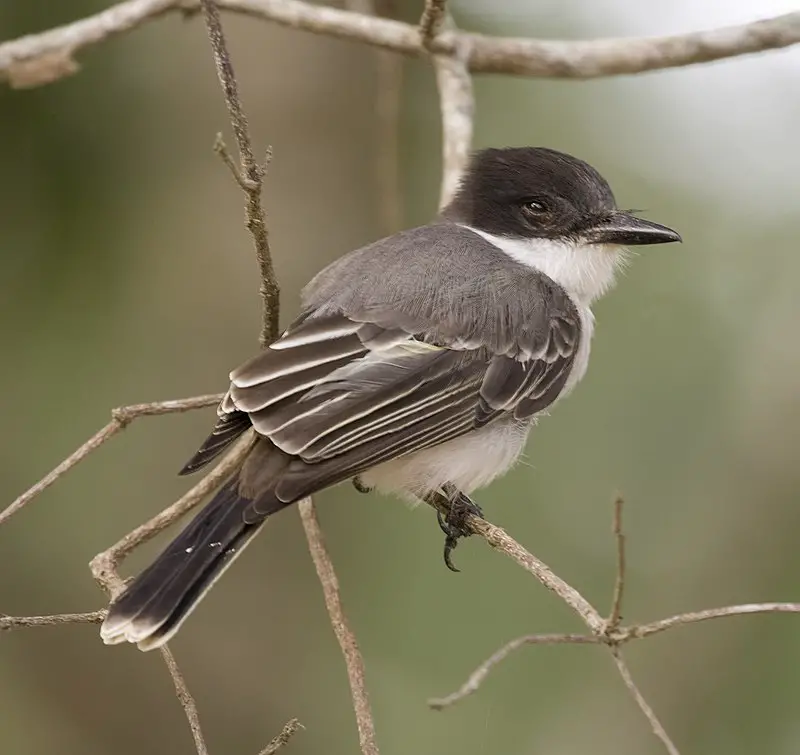
The Loggerhead Kingbird is a beautiful species of bird found in the West Indies, Bahamas, Cayman Islands, Cuba and Hispaniola. It prefers to inhabit subtropical or tropical moist lowland forests as well as montane forest habitats.
The kingbird has striking plumage with greyish-blue upperparts and bright yellow underparts. Its long tail feathers are darkly tipped which helps it stand out from other birds in its range.
This species feeds on insects such as beetles, grasshoppers and dragonflies that can be caught mid-air during its aerial forays.
Nesting season begins between February to May where they typically build their nests near riverside trees or shrubs and lay two eggs at once before incubating them for about 13 days till hatching occurs.
Although not yet threatened by extinction this shy creature should still be appreciated by all nature lovers who get lucky enough to observe one.Scientific classification:
| Kingdom | Animalia |
| Phylum | Chordata |
| Class | Aves |
| Order | Passeriformes |
| Family | Tyrannidae |
| Genus | Tyrannus |
| Species | T. caudifasciatus |
22. Bananaquit
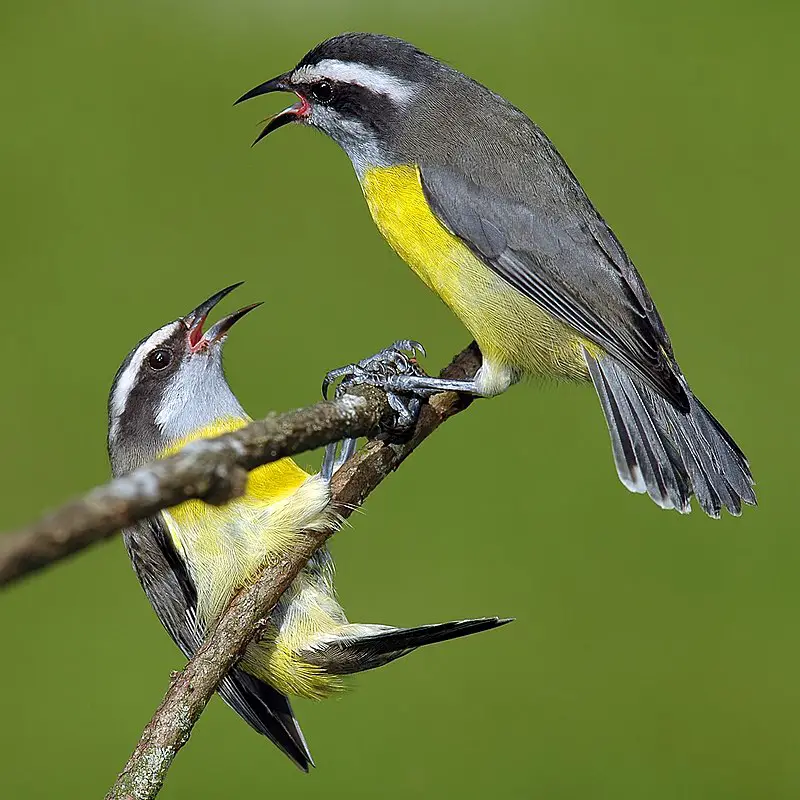
The Bananaquit, scientifically known as Coereba flaveola, is a small passerine bird belonging to the tanager family Thraupidae.
It was previously classified in either its own monotypic family or with other species such as buntings and New World sparrows (Emberizidae) or warblers (Parulidae).
This beautiful little bird has a yellow-green upper body, pale grey head and chestnut brown wings.
Its tail feathers are blackish while its belly is white with some faint streaks of olive green coloration.
The bananaquit can be found across Central America and the Caribbean islands where it feeds on fruits like bananas for which it gets its name from.Scientific classification:
| Kingdom | Animalia |
| Phylum | Chordata |
| Class | Aves |
| Order | Passeriformes |
| Family | Thraupidae |
| Genus | Coereba Vieillot, 1809 |
| Species | C. flaveola |
Also Featured In: Dominican Republic birds, Rainforest Birds You Should Know
23. Spindalis
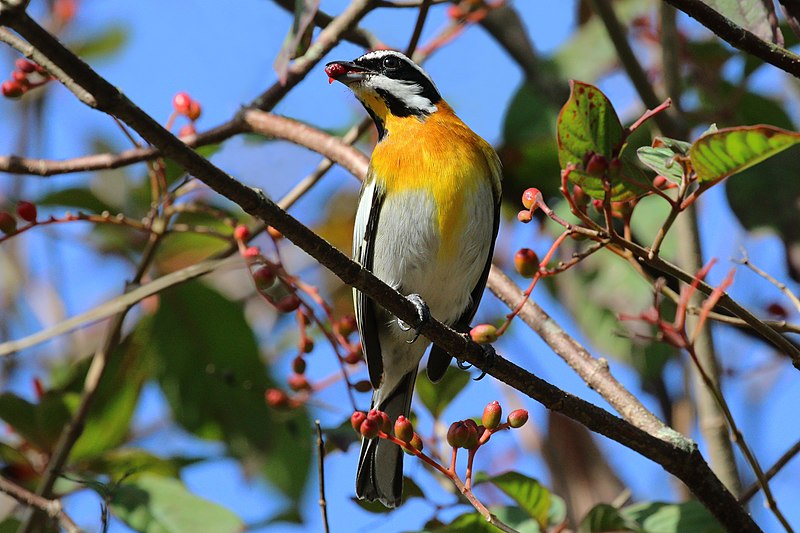
Spindalis is a genus of four species of non-migratory birds belonging to the family Spindalidae. Most are endemic to the West Indies, but there are also populations in Cozumel Island off Yucatán Peninsula and southeastern Florida.
These birds have traditionally been considered aberrant tanagers due to their similarity in appearance with them.
They have small bodies, short wings and long tails which they use for agility when feeding on fruits or invertebrates found on trees or shrubs.
The plumage varies across species from greenish yellow combined with browns and blacks to bright yellows mixed with reds, blues and greens depending on sex/seasonal changes.
Their diet includes mostly fruit but can supplement it by hunting insects while flying as well as eating nectar from flowers occasionally too.Scientific classification:
| Kingdom | Animalia |
| Phylum | Chordata |
| Class | Aves |
| Order | Passeriformes |
| Superfamily | Emberizoidea |
| Family | Spindalidae Barker, Burns, Klicka, Lanyon, & Lovette, 2013[1] |
| Genus | Spindalis Jardine & Selby, 1837 |
24. White-Tailed Tropicbird
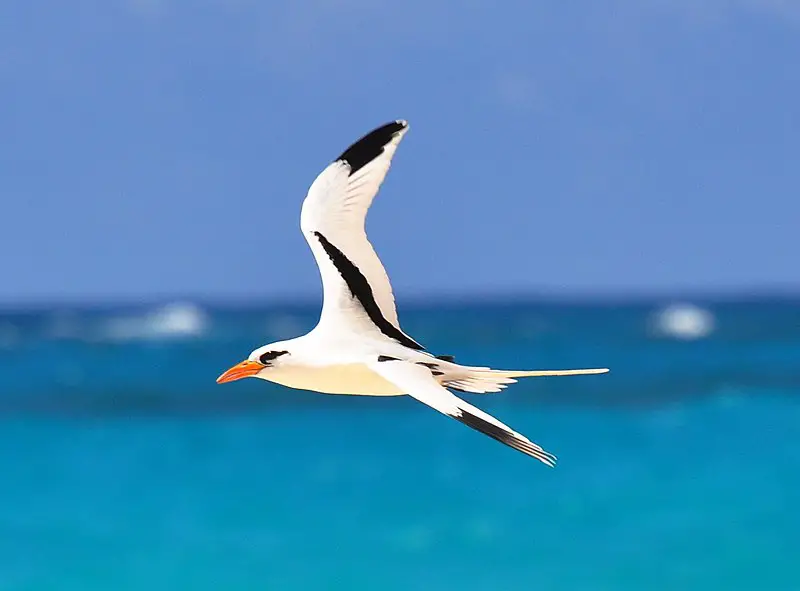
The White-tailed Tropicbird is a beautiful seabird that lives in the tropical waters of the Atlantic, Pacific, and Indian Oceans.
It is the smallest member of its order Phaethontiformes, measuring only 28 inches from head to tail.
Its wingspan can reach up to 45 inches wide. The bird has white plumage with black markings on its wings and tail feathers.
It also has an unmistakable long streamer which trails out behind them when they are in flight – a characteristic feature for all tropicbirds.
They nest mainly on remote islands throughout their range but have recently begun nesting on Little Tobago as well.
These birds feed primarily off flying fish or squid near the ocean’s surface during daylight hours before returning back home at nightfall.Scientific classification:
| Kingdom | Animalia |
| Phylum | Chordata |
| Class | Aves |
| Order | Phaethontiformes |
| Family | Phaethontidae |
| Genus | Phaethon |
| Species | P. lepturus |
Also Featured In: Mauritius birds, Birds of Kauai, Hawaii
25. Black-Faced Grassquit
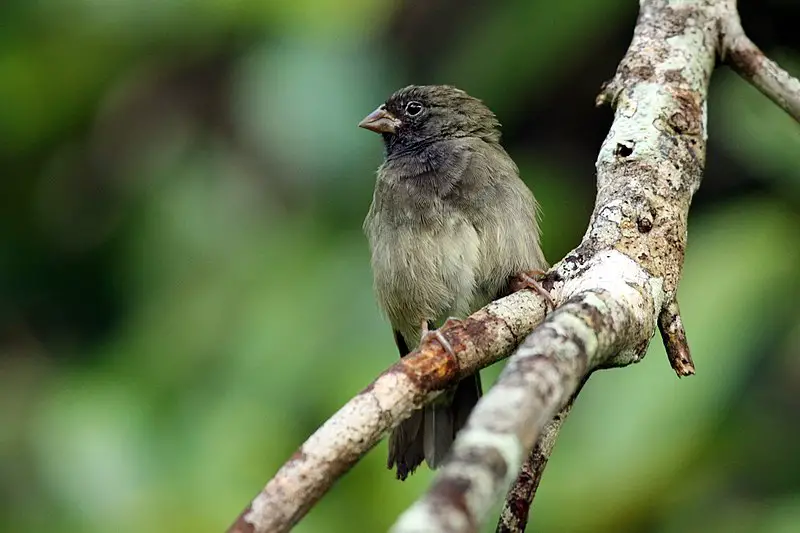
The Black-faced grassquit is a small bird belonging to the tanager family, genetically related to Darwin’s finches. It breeds mainly in the West Indies and along certain parts of Colombia and Venezuela.
The Swedish naturalist Carl Linnaeus first formally described it back in 1766 as part of his twelfth edition work on species classification.
This type of bird has a black head with white spots around its eyes, grey wings and tail feathers; its body is brownish orange or yellow with darker shades towards the belly area.
Its diet consists mostly of seeds from grasses but may also include other insects for additional nutrition during breeding season.Scientific classification:
| Kingdom | Animalia |
| Phylum | Chordata |
| Class | Aves |
| Order | Passeriformes |
| Family | Thraupidae |
| Genus | Melanospiza |
| Species | M. bicolor |
Also Featured In: Bahamas Birds, Common Margarita Island Birds
26. Pearly-Eyed Thrasher
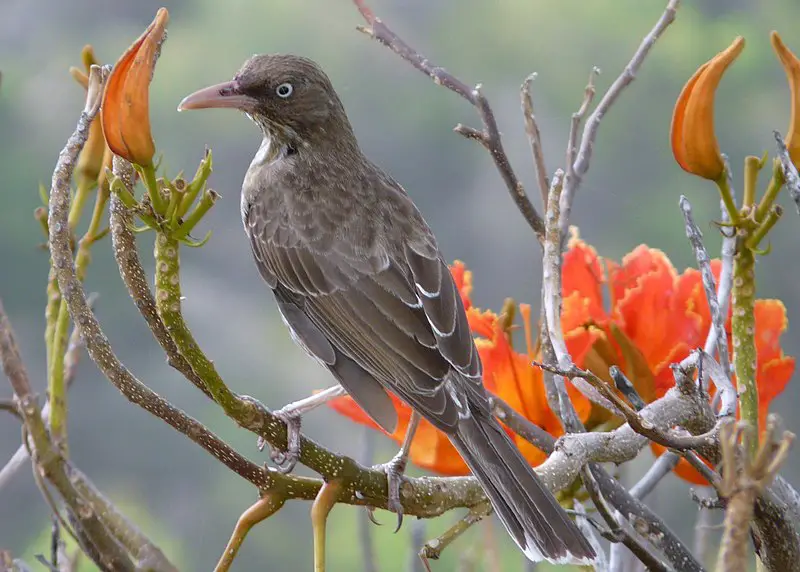
The Pearly-eyed Thrush is a unique and beautiful bird native to the Caribbean islands. It has stunning pearly eyes, with white patches on its wings and tail.
This thrasher measures up to 28-30 cm in length, making it the largest species of Mimidae family found in this area.
With an isolated subspecies living on Bonaire island, these birds have adapted well to their environment over time.
They feed mainly on insects found around them, but will also eat fruits or berries when available for extra nourishment.
These birds are often seen singing together as part of group displays at dawn or dusk – one more reason why they are so special.Scientific classification:
| Kingdom | Animalia |
| Phylum | Chordata |
| Class | Aves |
| Order | Passeriformes |
| Family | Mimidae |
| Genus | Margarops P.L. Sclater, 1859 |
| Species | M. fuscatus |
Also Featured In: Martinique Island Birds You Should Know, Winged Marvels of St Martin’s: A Bird Enthusiast’s Delight
27. Scaly-Naped Pigeon
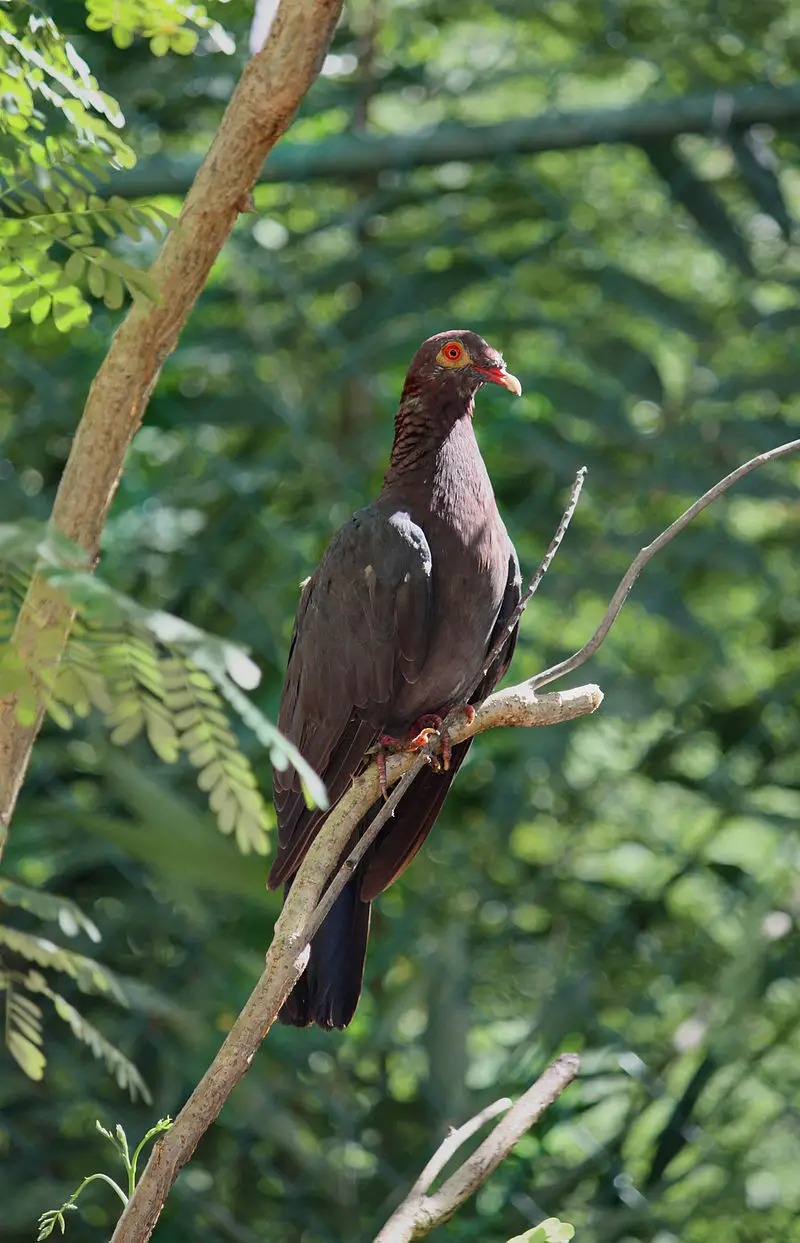
The scaly-naped pigeon is a large bird belonging to the family Columbidae. It has slate grey plumage with maroon coloured feathers around its neck, giving it the common name of red-necked pigeon.
The species originates from throughout the Caribbean and can reach 14–16 inches in length.
Its scientific name is derived from its unique feature: small scales on its nape which form an attractive pattern when viewed up close.
This makes them easily distinguishable from other birds within their range as they are one of few that have this characteristic.
They feed mainly on fruit but also consume seeds, insects and even carrion depending on availability at any given time of year or location.Scientific classification:
| Kingdom | Animalia |
| Phylum | Chordata |
| Class | Aves |
| Order | Columbiformes |
| Family | Columbidae |
| Genus | Patagioenas |
| Species | P. squamosa |
Also Featured In: Common Birds of Turks and Caicos Islands, Native Birds Of Middle Caicos
28. Gray Kingbird
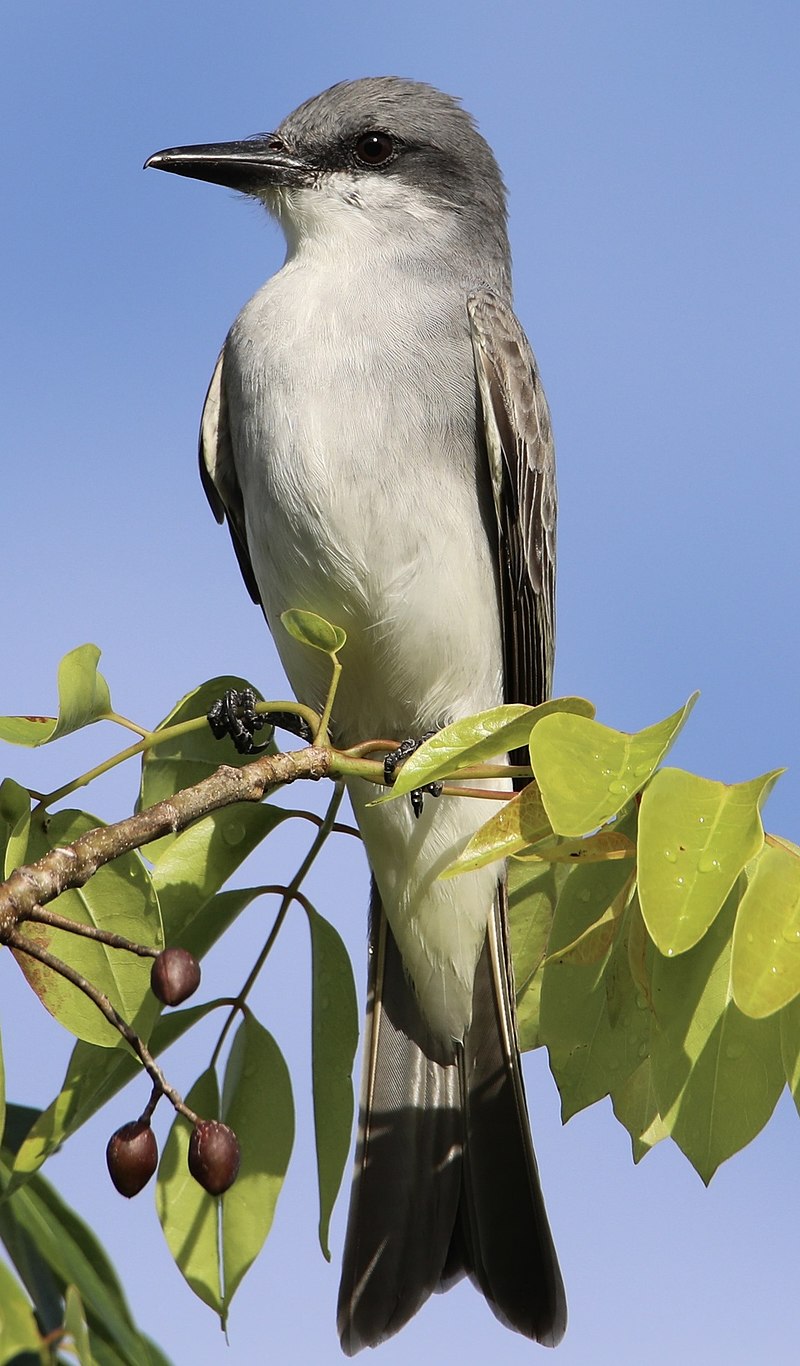
The Gray Kingbird is a species of tyrant flycatcher found in tall trees and shrubs, including the edges of savannas and marshes. It has gray feathers on its back with white underparts and blackish wings.
Its head is dark gray-brown or olive, while its tail is tipped with white. The Gray Kingbird builds flimsy cup nests from twigs in tree branches for their eggs to incubate safely until they hatch into chicks.
They feed mainly on insects such as moths, grasshoppers, beetles, crickets and caterpillars that can be caught midair when it swoops down from above like other kingbirds do.
This bird’s call consists of loud chirps which are often heard during mating season – making them an easily identifiable species within areas where they live.Scientific classification:
| Kingdom | Animalia |
| Phylum | Chordata |
| Class | Aves |
| Order | Passeriformes |
| Family | Tyrannidae |
| Genus | Tyrannus |
| Species | T. dominicensis |
Also Featured In: Barbados Birds, Birds That Live In Boca Grande
29. Zenaida Dove
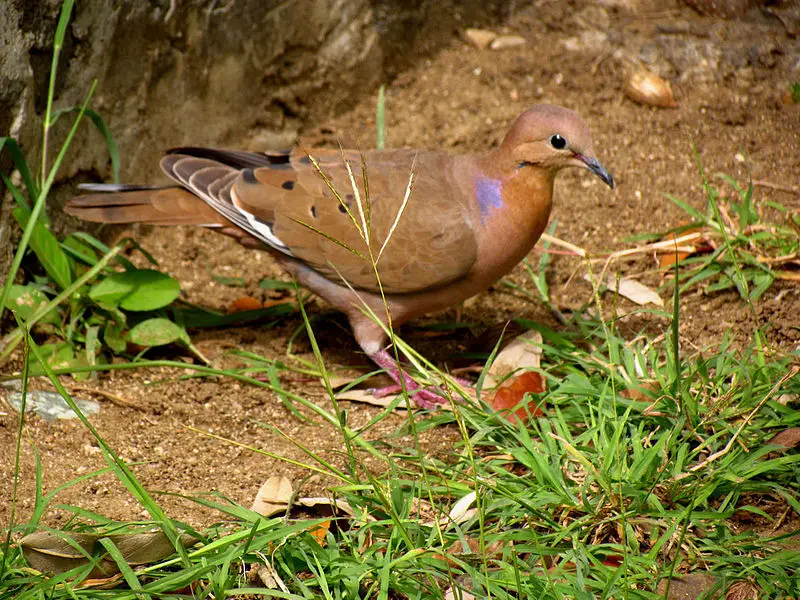
The Zenaida dove is a species of doves and pigeons found mainly in the Caribbean, but also parts of Mexico, Central America and South America.
With its distinct dark coloring, short rounded tail and an average length of 28-30 cm (11-12 inches), it stands out from other bird families.
It’s recognized as the national bird for Anguilla where locals refer to it as ‘turtle dove’. They are seen flying around open grasslands or roosting on tree branches close by populated areas.
These birds feed mostly on seeds that they pick off the ground while walking through fields.
The Zenaida Dove breeds all year round producing two broods during spring and summer months with both male and female taking turns incubating eggs over a span of 14 days before hatching into chicks.Scientific classification:
| Kingdom | Animalia |
| Phylum | Chordata |
| Class | Aves |
| Order | Columbiformes |
| Family | Columbidae |
| Genus | Zenaida |
| Species | Z. aurita |
Also Featured In: Great Abaco Island Birds, Native Birds Of Guadeloupe Island
30. Caribbean Elaenia
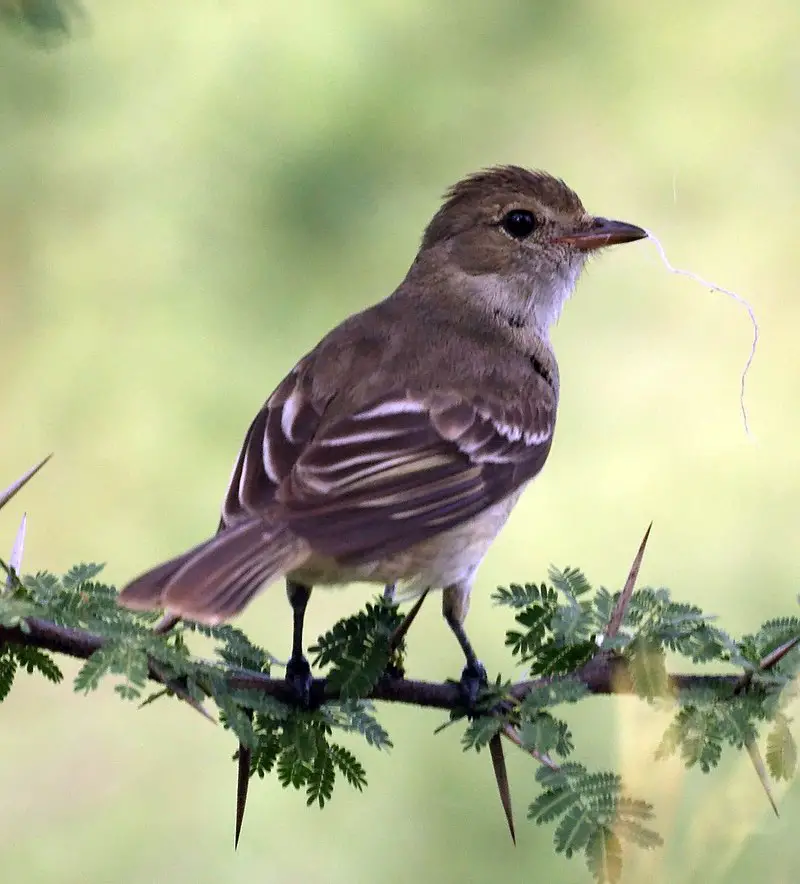
The Caribbean elaenia is a species of small bird that can be found in the West Indies and parts of Central America.
It is part of the Tyrannidae family and inhabits tropical dry broadleaf forests, subtropical or tropical moist lowland forests, as well as heavily degraded former forest areas.
In 1760, French zoologist Mathurin Jacques Brisson provided an extensive description on this species which has helped us gain further knowledge about it today.
The Caribbean elaenia typically measures around 6-9 inches long with predominantly olive green feathers with yellowish edges to some wings and tails.
They have white throats but lack any distinctive markings on their chest unlike many other birds from its family.
This bird feeds primarily on insects such as grasshoppers collected from trees or bushes while also consuming fruit when available during certain times of year.Scientific classification:
| Kingdom | Animalia |
| Phylum | Chordata |
| Class | Aves |
| Order | Passeriformes |
| Family | Tyrannidae |
| Genus | Elaenia |
| Species | E. martinica |
Also Featured In: Common Birds Found near Necker Island,
31. Lesser Antillean Pewee
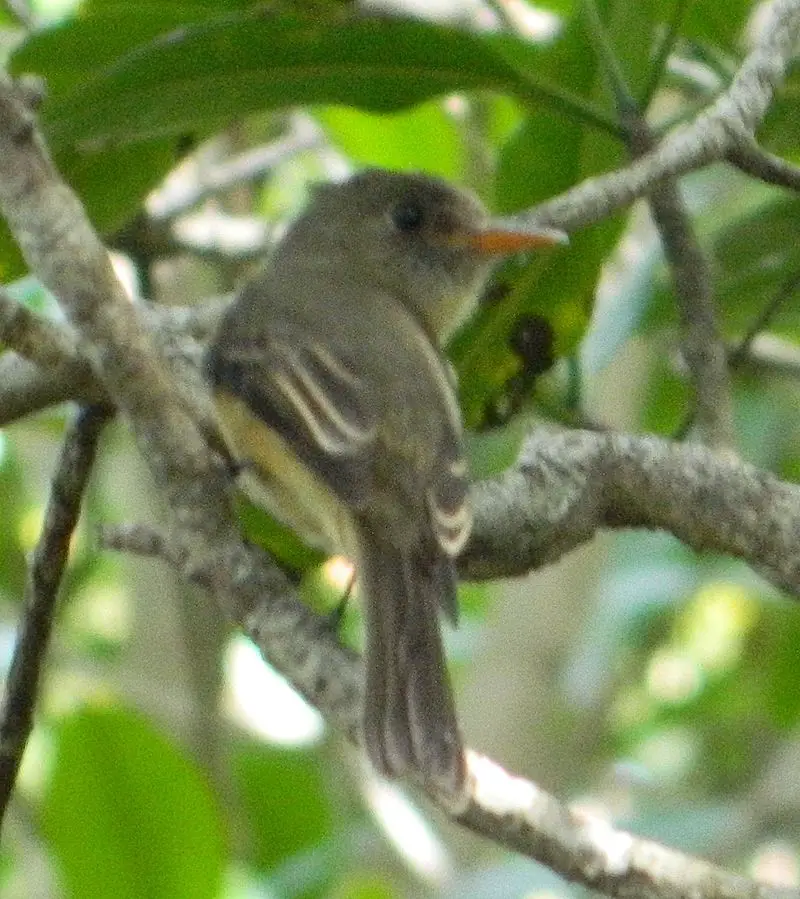
The Lesser Antillean pewee is a species of bird found in the family Tyrannidae. It can be spotted in Dominica, Guadeloupe, Martinique, Puerto Rico and Saint Lucia with records from Saint Kitts.
In fact some experts suggest that birds on Puerto Rico are different enough to be considered their own species (Puerto Rican pewee) while those living on St Lucia are also distinct enough to have been named ‘St Lucian Pewees’.
This small songbird prefers habitats like tropical or subtropical moist lowland forests as well as heavily degraded former forest areas.
With its drab grayish-brown plumage it’s rather unassuming but during breeding season males will give a distinctive “churrr” call which makes them easier to spot.Scientific classification:
| Kingdom | Animalia |
| Phylum | Chordata |
| Class | Aves |
| Order | Passeriformes |
| Family | Tyrannidae |
| Genus | Contopus |
| Species | C. latirostris |
Also Featured In: Saint Lucia Birds,
32. Eastern Kingbird
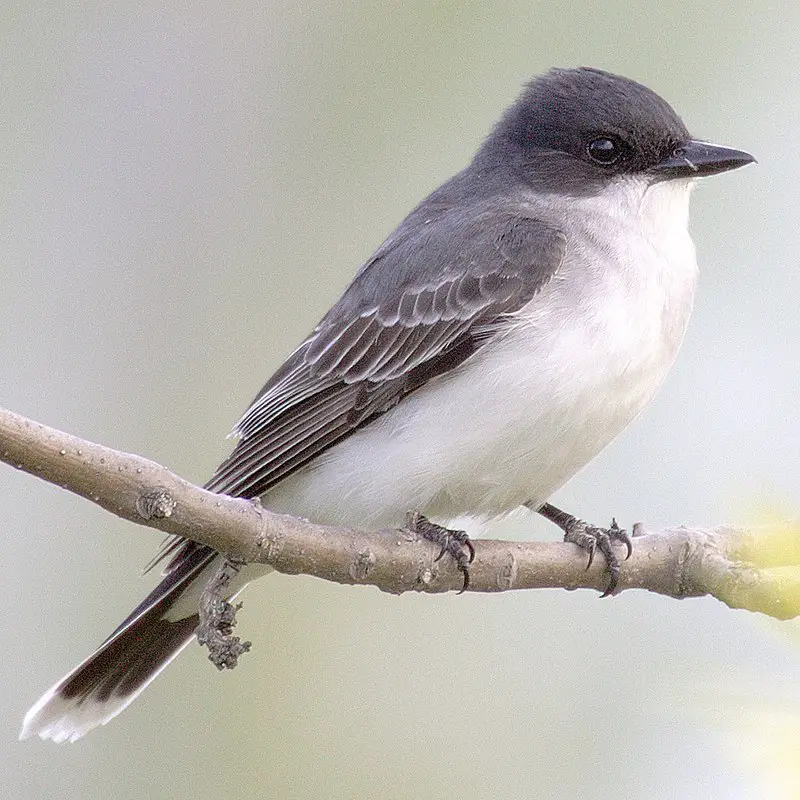
The Eastern kingbird is an impressive large grey bird, with a white underbelly and pointed wings. It can be seen perched atop trees or bushes in open areas while foraging for insects.
This species of tyrant flycatcher breeds across much of North America during the spring and summer months before migrating southwards come wintertime.
During this time, they have been known to travel as far south as Central and South America.
These birds are particularly territorial when nesting; having been observed chasing off even larger animals such as hawks away from their nests. A truly remarkable sight to behold.Scientific classification:
| Kingdom | Animalia |
| Phylum | Chordata |
| Class | Aves |
| Order | Passeriformes |
| Family | Tyrannidae |
| Genus | Tyrannus |
| Species | T. tyrannus |
Also Featured In: Flycatchers Species, Common Birds in Saskatchewan
33. Grasshopper Sparrow
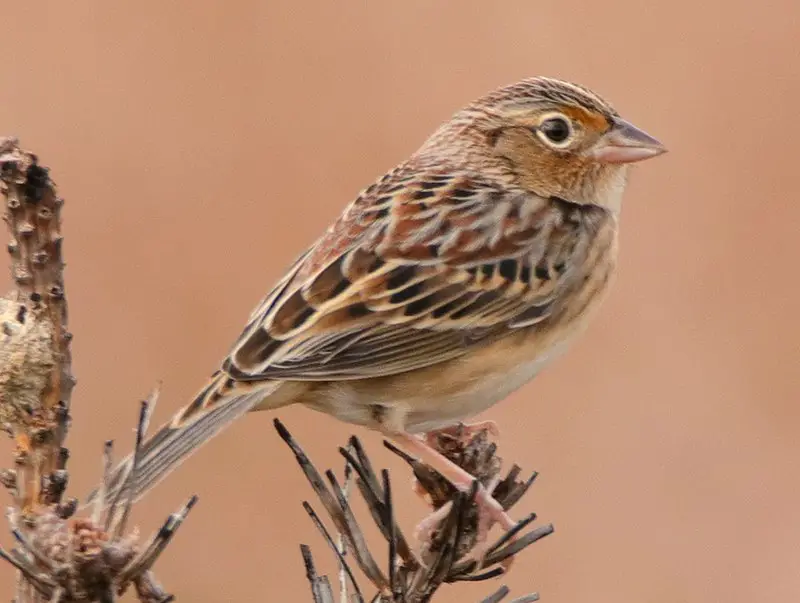
The Grasshopper Sparrow is a small sparrow from the New World. It inhabits grasslands and prairies, but will also colonize reclaimed grassland or crop fields.
This species prefers large areas of open grassland where it avoids trees and shrubs.
Its diet consists mainly of seeds, insects and spiders which it looks for on the ground while walking or running with occasional short flights to find food in tall vegetation.
The breeding season begins in late April when males sing their characteristic buzzy song to attract females; pairs build nests either low on the ground or aboveground among weeds and other cover plants.
These birds are key members of their native ecosystems as they control insect populations by feeding upon them as well as dispersing seed through consuming fruits.Scientific classification:
| Kingdom | Animalia |
| Phylum | Chordata |
| Class | Aves |
| Order | Passeriformes |
| Family | Passerellidae |
| Genus | Ammodramus |
| Species | A. savannarum |
Also Featured In: Sparrows Species, Birds that Live in the Grasslands
34. Puerto Rican Amazon
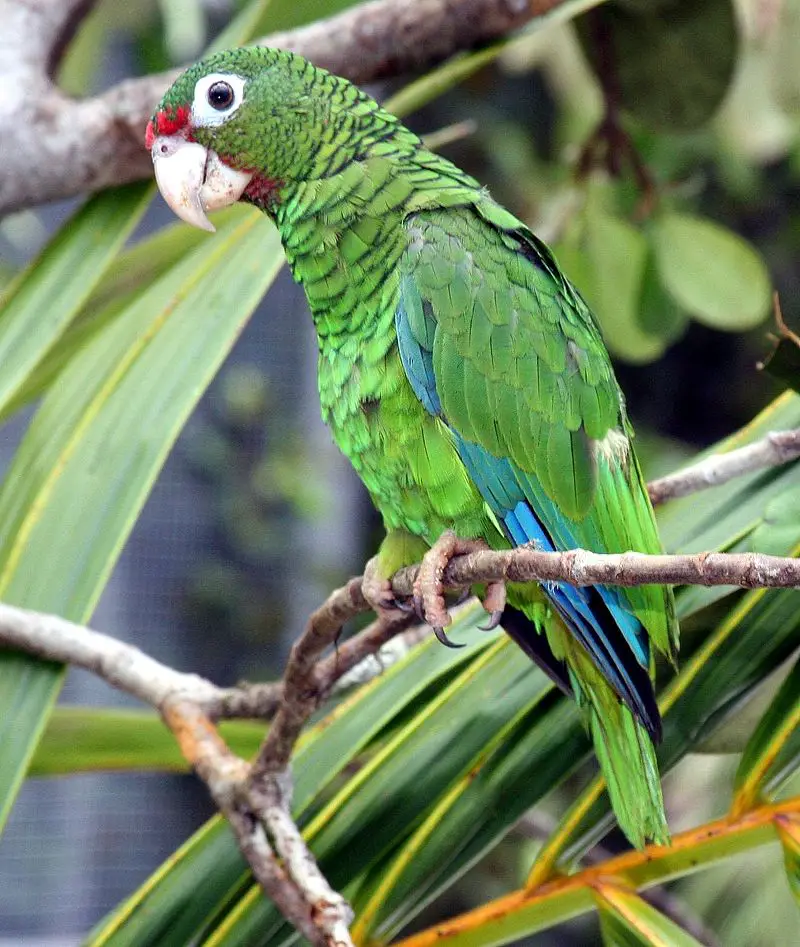
The Puerto Rican amazon is a unique parrot species found only in Puerto Rico. It is also known as the Puerto Rican parrot or iguaca. This bird is part of the Amazona genus and measures around 28-30 cm in length.
Most of its body is green, with a striking red forehead and white rings around its eyes. Sadly, this parrot is endangered due to habitat loss, hunting, and disease, and there are currently only around 300 in the wild.
Conservation efforts, however, have helped to increase their population through breeding programs and habitat preservation.
The Puerto Rican amazon represents an important part of Puerto Rico’s ecological and cultural heritage, and its survival is essential for maintaining the island’s biodiversity.Scientific classification:
| Kingdom | Animalia |
| Phylum | Chordata |
| Class | Aves |
| Order | Psittaciformes |
| Family | Psittacidae |
| Genus | Amazona |
| Species | A. vittata |
35. Puerto Rican Spindalis
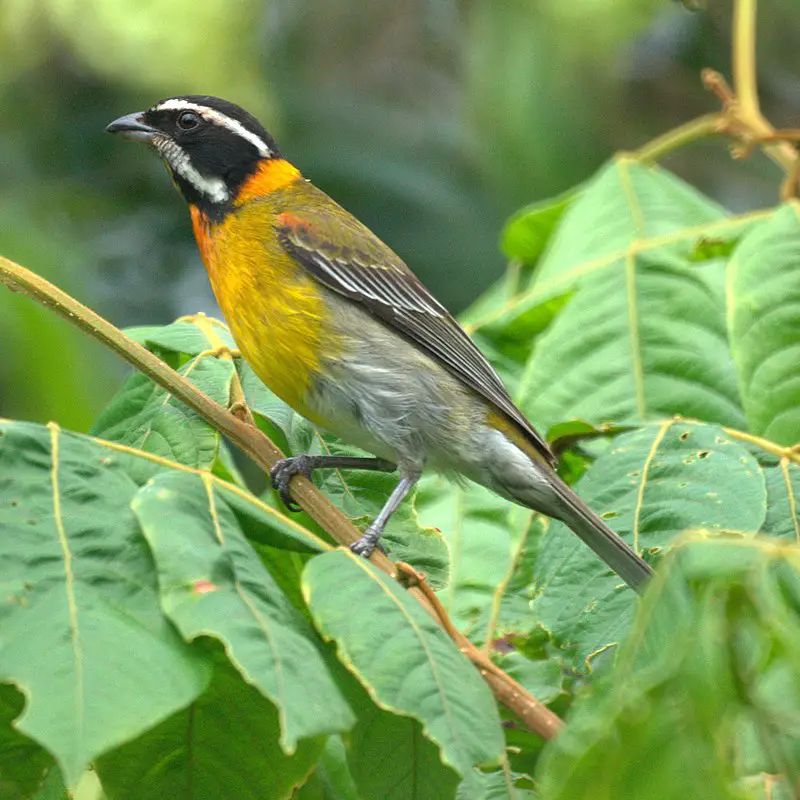
The Puerto Rican spindalis, also known as reina mora, is an endemic bird found in Puerto Rico. It plays a crucial role in the ecosystem by aiding in seed dispersal and plant reproduction.
This bird is widely distributed throughout the island and is an important part of Puerto Rican biodiversity. As the unofficial national bird of Puerto Rico, the Puerto Rican spindalis holds cultural significance and represents the country’s rich natural heritage.
With its vibrant colors and distinctive appearance, it is a joy to see in its natural habitat.
Overall, the Puerto Rican spindalis is a key species that helps maintain the balance of the island’s local biodiversity.Scientific classification:
| Kingdom | Animalia |
| Phylum | Chordata |
| Class | Aves |
| Order | Passeriformes |
| Family | Spindalidae |
| Genus | Spindalis |
| Species | S. portoricensis |
36. Puerto Rican Tody
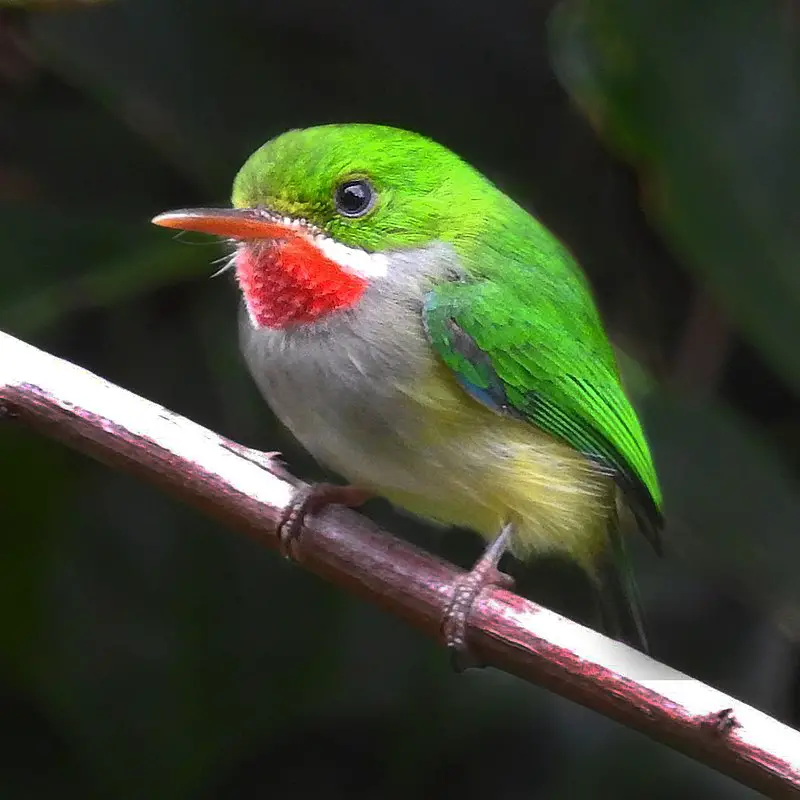
The Puerto Rican tody, also known as “San Pedrito” or “half-dollar bird”, is a unique bird species found only in Puerto Rico. These birds are closely related to the motmots found in Central America.
It is believed that the Puerto Rican tody originated from the Jamaican tody, which was dispersed during a hurricane. These tiny birds are highly appreciated by locals for their vivid green plumage and distinctive calls.
They have a small but sturdy beak that they use to catch insects, which makes up a significant part of their diet.
The Puerto Rican tody has become a symbol of Puerto Rico’s remarkably diverse wildlife and is highly protected by conservation efforts.Scientific classification:
| Kingdom | Animalia |
| Phylum | Chordata |
| Class | Aves |
| Order | Coraciiformes |
| Family | Todidae |
| Genus | Todus |
| Species | T. mexicanus |
37. Puerto Rican Woodpecker
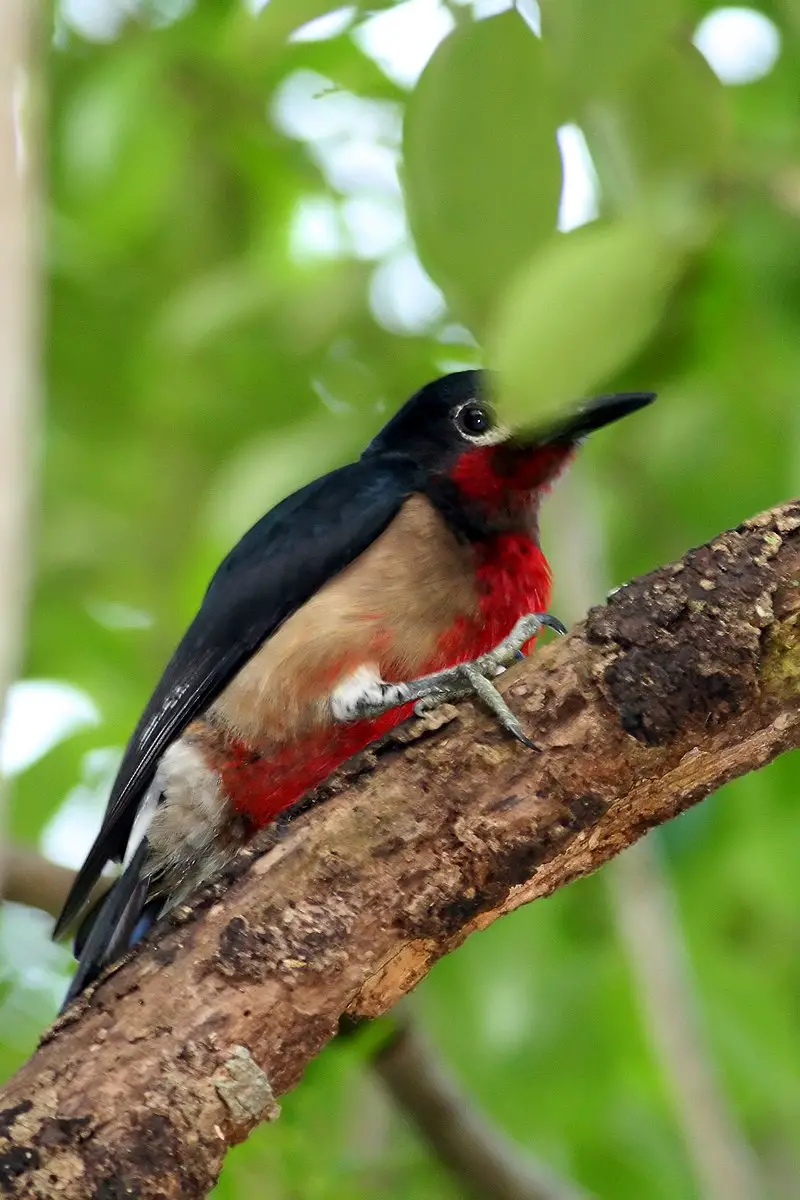
The Puerto Rican woodpecker is a unique bird found only in Puerto Rico. It is part of the Melanerpes genus and one of only five woodpecker species in the Antilles.
Unlike other woodpecker species, this bird only resides in Puerto Rico and is the only constant member of the Picidae family found there. While it is common on the main island of Puerto Rico, it is considered rare on the island of Vieques.
This woodpecker’s distinctive appearance and behavior make it a favorite among birdwatchers in the region. Its beautiful coloring, marked by a bright red head, makes it unmistakable.
Additionally, its ability to drum on trees to communicate and locate food adds to its fascinating character.
Overall, the Puerto Rican woodpecker is a unique and beloved species that is important to the Puerto Rican ecosystem.Scientific classification:
| Kingdom | Animalia |
| Phylum | Chordata |
| Class | Aves |
| Order | Piciformes |
| Family | Picidae |
| Genus | Melanerpes |
| Species | M. portoricensis |
38. Adelaide’s Warbler
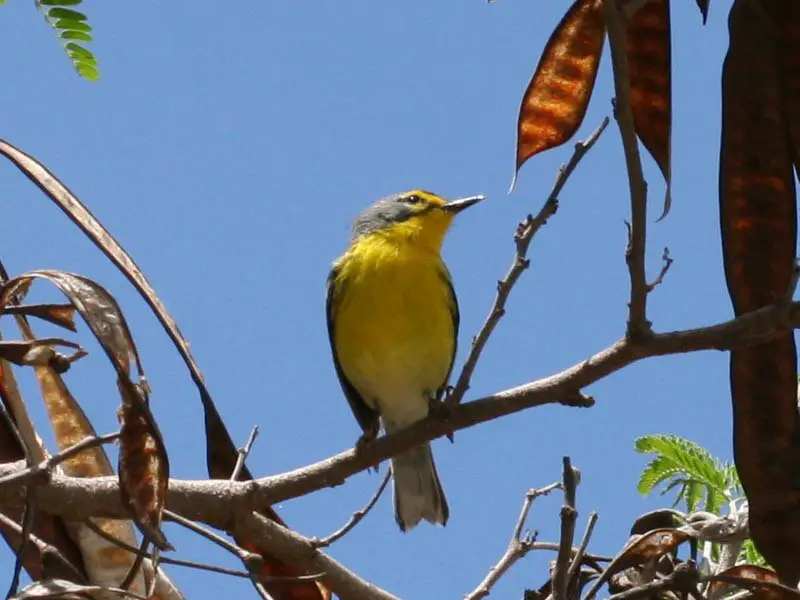
Adelaide’s warbler is a unique bird species that can only be found in the archipelago of Puerto Rico. This bird belongs to the Setophaga genus and the Parulidae family.
The species was named after Adelaide Swift, who is the daughter of Robert Swift, who caught the first specimen.
The S. adelaidae complex used to be considered as one species, with populations living in Barbuda, Puerto Rico, and St. L. This bird’s appearance and behavior have not been mentioned in the info given.
However, being endemic to a particular archipelago makes this species a vital part of the ecosystem there.
The fact that it was named after a person reflects the significant contribution made by early bird watchers and researchers to understanding the unique flora and fauna of that region.Scientific classification:
| Kingdom | Animalia |
| Phylum | Chordata |
| Class | Aves |
| Order | Passeriformes |
| Family | Parulidae |
| Genus | Setophaga |
| Species | S. adelaidae |
39. Elfin Woods Warbler
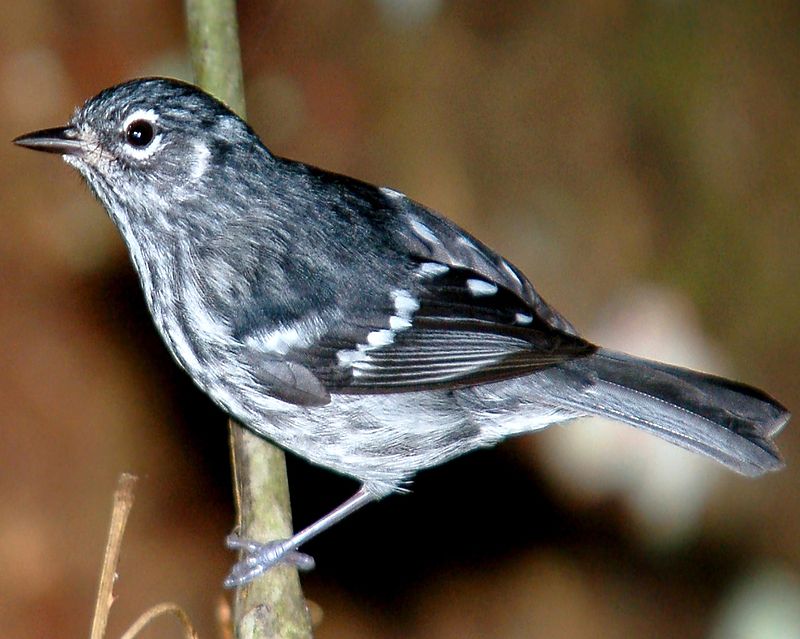
The Elfin woods warbler is a rare and local bird species found only in Puerto Rico. It was discovered in 1968 and described in 1972, making it the most recently described New World warbler.
The species is named after Angela Kepler, one of its discoverers. These birds are insectivores and feed by gleaning small insects off their habitat.
They have a unique appearance with bright yellow feathers, black streaks on the head, and a small curved bill.
Due to habitat destruction and degradation, the Elfin woods warbler is classified as endangered.
Conservation efforts are underway to protect the remaining population and preserve its natural habitat in Puerto Rico.The survival of this bird species is crucial, and educating the public about their significance is essential to their conservation.Scientific classification:
| Kingdom | Animalia |
| Phylum | Chordata |
| Class | Aves |
| Order | Passeriformes |
| Family | Parulidae |
| Genus | Setophaga |
| Species | S. angelae |
40. Puerto Rican Nightjar
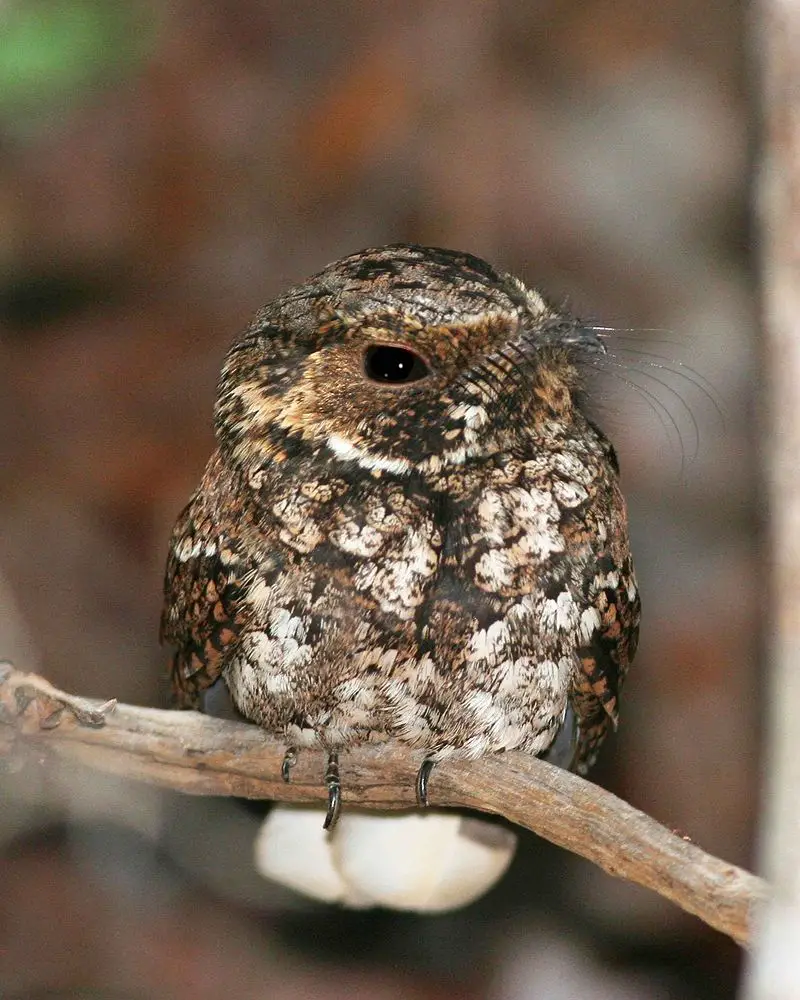
The Puerto Rican nightjar, also known as the Puerto Rican whip-poor-will, is a nocturnal bird that belongs to the nightjar family. It inhabits the dry coastal scrub forests of southwestern Puerto Rico, mainly in localized areas.
The species was first identified through bones found in a cave in north central Puerto Rico in 1916, and a single skin specimen from 1888.
However, it was considered extinct until it was spotted in the wild in 1961. The bird is small in size and feeds on insects while flying low to the ground.
It has a distinct call, which sounds like “churr chuurr churr” and is most active at night.
Despite being considered endangered due to habitat loss and deforestation, conservation efforts have been put in place to protect this unique and rare species.Scientific classification:
| Kingdom | Animalia |
| Phylum | Chordata |
| Class | Aves |
| Clade | Strisores |
| Order | Caprimulgiformes |
| Family | Caprimulgidae |
| Genus | Antrostomus |
| Species | A. noctitherus |
41. Yellow-Shouldered Blackbird
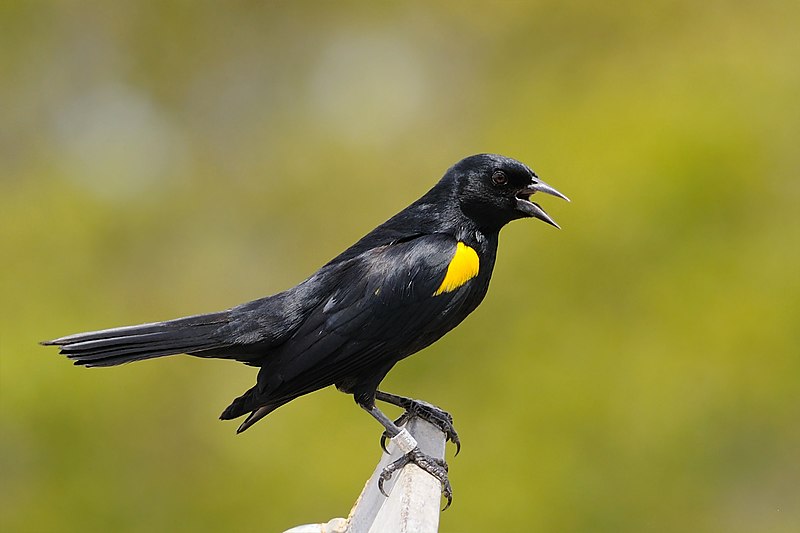
The yellow-shouldered blackbird is a native species to Puerto Rico, recognizable by its black feathers and bold yellow patch on its wing. Both male and female adults share a similar appearance.
These birds are primarily insectivorous, consuming a wide range of insects as their primary food source.
They are commonly known as mariquita de Puerto Rico or capitán in Puerto Rican Spanish.
The scientific name for this bird is Agelaius xanthomus, with the nominate form being A. x. xantho.
As an endemic species, conservation efforts are underway to protect the yellow-shouldered blackbird and preserve its habitat in Puerto Rico.Scientific classification:
| Kingdom | Animalia |
| Phylum | Chordata |
| Class | Aves |
| Order | Passeriformes |
| Family | Icteridae |
| Genus | Agelaius |
| Species | A. xanthomus |
Also Featured In: Black Birds that Live around United States of America,
42. Puerto Rican Bullfinch
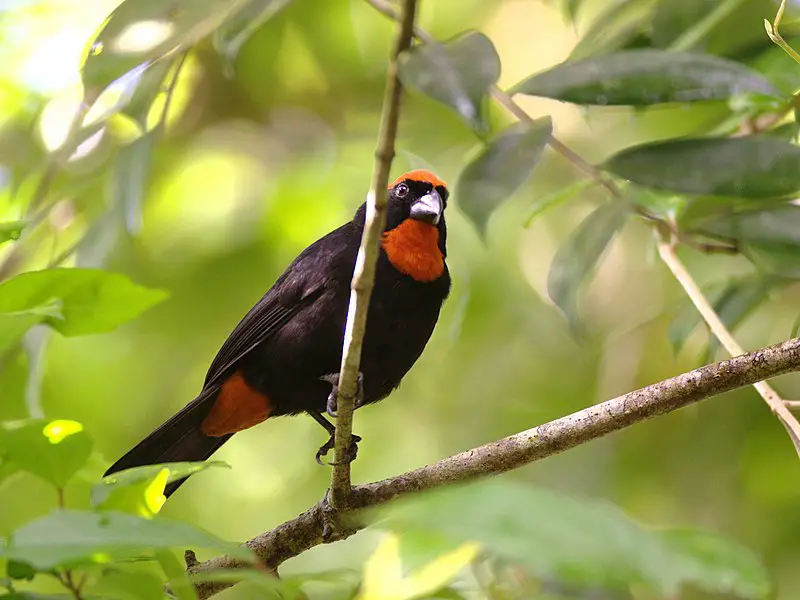
The Puerto Rican bullfinch, a small tanager, is native to Puerto Rico’s forests, with the exception of the easternmost part of the island. Along with seeds and fruits, it feeds on insects and spiders.
Its spherical nest with a side entrance is laid with typically three light green eggs.Scientific classification:
| Kingdom | Animalia |
| Phylum | Chordata |
| Class | Aves |
| Order | Passeriformes |
| Family | Thraupidae |
| Genus | Melopyrrha |
| Species | M. portoricensis |
43. Puerto Rican Tanager
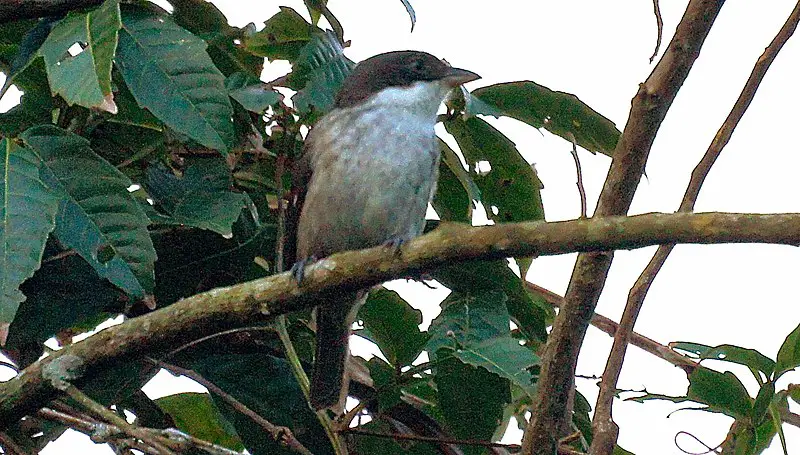
The Puerto Rican tanager is a unique passerine bird found only in the archipelago of Puerto Rico. This small bird has historically been classified under the tanager family, but recent studies suggest it could belong to its own family called Nesospingidae, or as part of Phaenicophilidae.
It is the only species in its genus, Nesospingus, and is closely related to spindalises.
The bird has a striking appearance with bright yellow plumage on its back and wings, contrasting with its black head, neck, and chest. Its underparts are white or pale yellow, and it has a sharp, pointed beak.
The Puerto Rican tanager’s diet consists of insects, fruit, and seeds, and it is known to inhabit humid montane forests and tropical rainforests
Sadly, like many bird species, the Puerto Rican tanager faces threats such as habitat destruction and predation by introduced species.
Conservation efforts are underway to protect this unique and valuable bird.Scientific classification:
| Kingdom | Animalia |
| Phylum | Chordata |
| Class | Aves |
| Order | Passeriformes |
| Superfamily | Emberizoidea |
| Family | Nesospingidae Barker, Burns, Klicka, Lanyon, & Lovette, 2013 |
| Genus | Nesospingus P.L. Sclater, 1885 |
| Species | N. speculiferus |
44. Puerto Rican Flycatcher
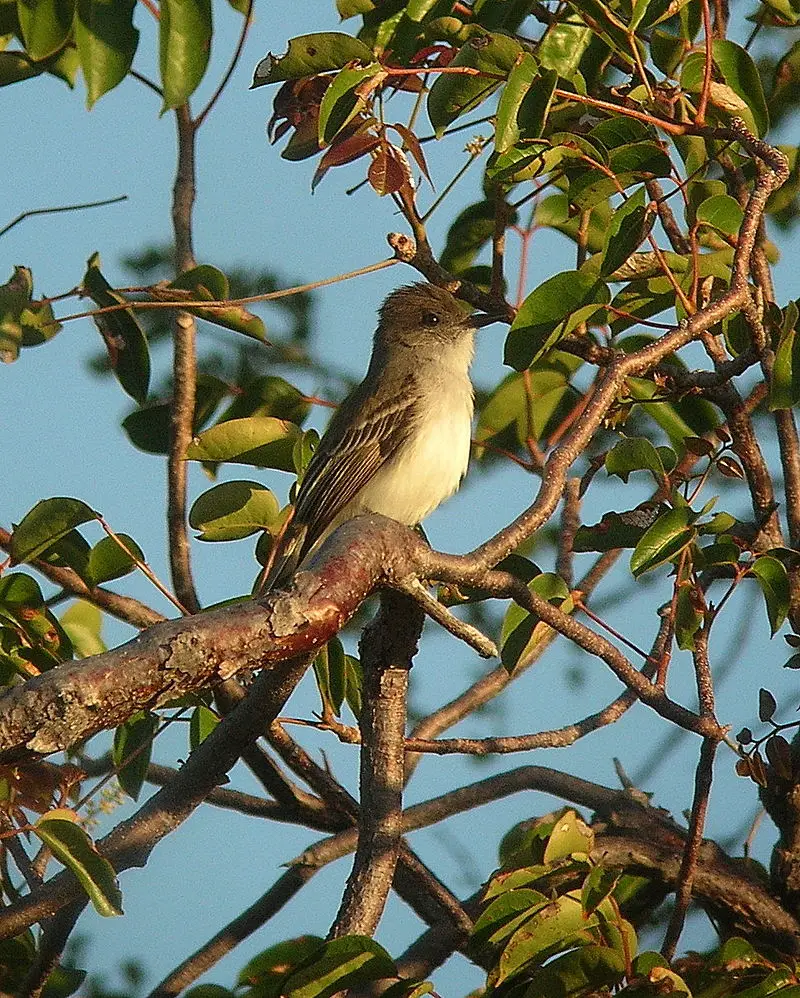
The Puerto Rican flycatcher, a member of the Tyrant flycatcher family, is only found in the Puerto Rican archipelago. It belongs to the Myiarchus genus and is one of its 22 species.
This species is unique to the Puerto Rican region and cannot be found anywhere else in the world.
With its small size and agile movements, this bird catches insects on the fly, hence its name ‘flycatcher.’ In Puerto Rico, these birds populate deciduous forests and wooded areas.
This species’ numbers have been on a steady decline. Threats to their habitat include urbanization and farming, leading to their classification as endangered by the International Union for Conservation of Nature (IUCN).
Conservation efforts are underway to save this bird species from extinction.Scientific classification:
| Kingdom | Animalia |
| Phylum | Chordata |
| Class | Aves |
| Order | Passeriformes |
| Family | Tyrannidae |
| Genus | Myiarchus |
| Species | M. antillarum |
Also Featured In: British Virgin Islands Birds You Need to See,
45. Puerto Rican Emerald
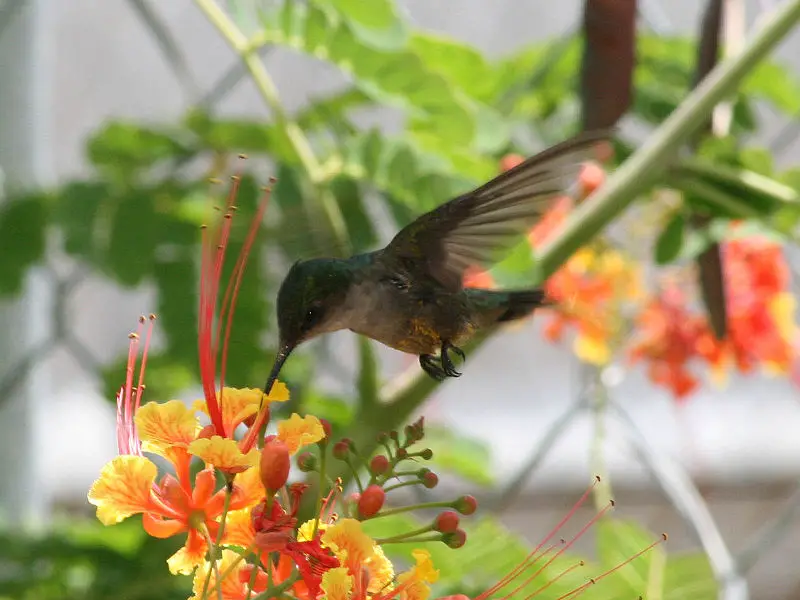
The Puerto Rican emerald, also known as zumbadorcito de Puerto Rico, is a species of hummingbird found only in Puerto Rico. It belongs to the “emeralds” tribe Trochilini of subfamily Trochilinae.
Previously it was classified under the genus Chlorostilbon. This bird is endemic to Puerto Rico and cannot be found anywhere else in the world. It has unique features like a green plumage and a tiny body.
These birds are very active and are generally found in forests or gardens. They feed on nectar and insects and play an important role in pollinating native plants.
Due to habitat loss and degradation, the Puerto Rican emerald population has declined over the years, making it a vulnerable species.
Conservation efforts are being made to protect the remaining population and their habitats.Scientific classification:
| Kingdom | Animalia |
| Phylum | Chordata |
| Class | Aves |
| Clade | Strisores |
| Order | Apodiformes |
| Family | Trochilidae |
| Genus | Riccordia |
| Species | R. maugaeus |
46. Puerto Rican Owl
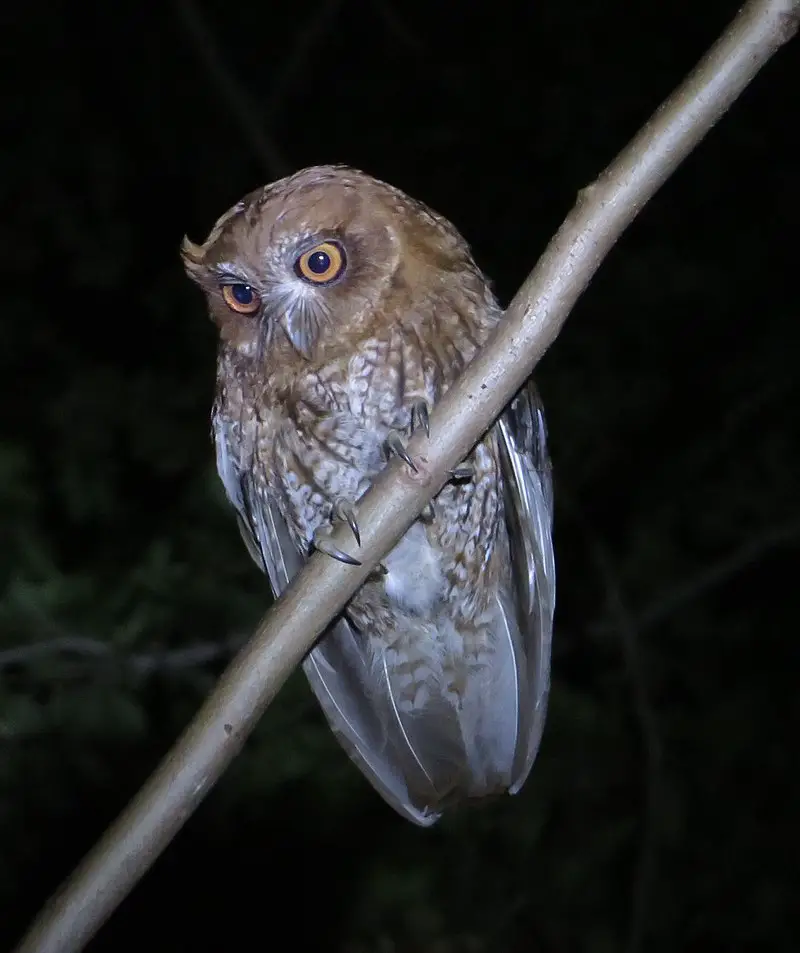
The Puerto Rican owl, also known as the múcaro común, is a mid-sized typical owl belonging to the subfamily Striginae.
It is an endemic species found in Puerto Rico, and was also previously found in the Virgin Islands.
The bird was described by the French zoologist François Marie Daudin in 1800.Scientific classification:
| Kingdom | Animalia |
| Phylum | Chordata |
| Class | Aves |
| Order | Strigiformes |
| Family | Strigidae |
| Genus | Gymnasio Bonaparte, 1854 |
| Species | G. nudipes |
47. Green Mango
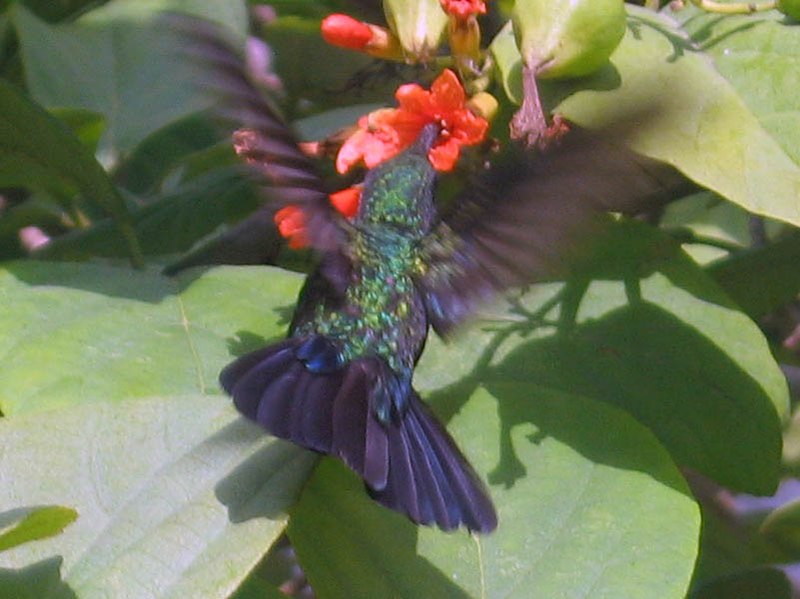
The Green Mango bird is a unique and fascinating species of hummingbird found only on the main island of Puerto Rico. Although its relationship with other Anthracothorax species remains unresolved, it is known to be the only member of its genus.
These birds are relatively small, measuring between 11 to 14 cm long, and weighing around 7 g.
The genders of the species are visually indistinguishable. With its striking green plumage, the Green Mango bird is a sight to behold. As a hummingbird, it has a rapid wingbeat and feeds mainly on nectar, and sometimes insects.
The Green Mango bird is a welcome addition to the diverse range of bird species found on the beautiful island of Puerto Rico.Scientific classification:
| Kingdom | Animalia |
| Phylum | Chordata |
| Class | Aves |
| Clade | Strisores |
| Order | Apodiformes |
| Family | Trochilidae |
| Genus | Anthracothorax |
| Species | A. viridis |
48. Puerto Rican Vireo
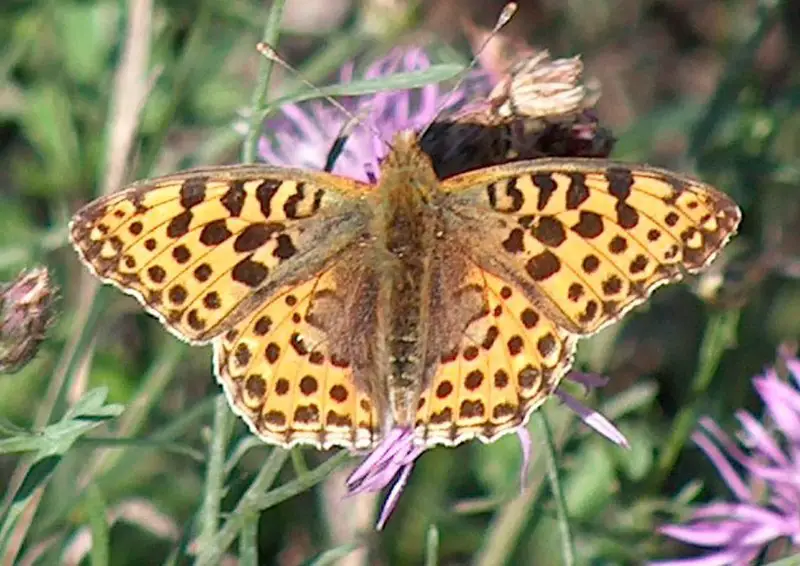
The Puerto Rican vireo is a unique bird found only in the archipelago of Puerto Rico. It belongs to the Vireo genus and is a part of the Vireonidae family.
Known by the local name “bien-te-veo,” which translates to “see-you-well,” the bird is not to be mistaken for the great kiskadee species found elsewhere. With a gray head and a white throat, the Puerto Rican vireo is a small bird and endemic to the region.
It is one of the 31 species of Vireo. Despite its size, the bird is known for its distinctive call.
Overall, the Puerto Rican vireo is a unique and fascinating part of Puerto Rico’s ecosystem.Scientific classification:
| Kingdom | Animalia |
| Phylum | Chordata |
| Class | Aves |
| Order | Passeriformes |
| Family | Vireonidae |
| Genus | Vireo |
| Species | V. latimeri |
49. Puerto Rican Oriole
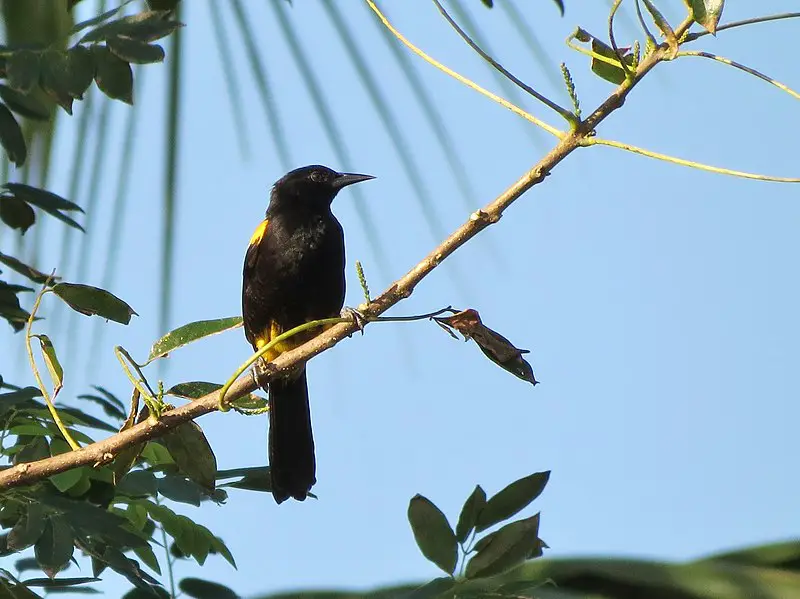
The Puerto Rican oriole, also known as Icterus portoricensis, belongs to the Icteridae family of birds. This species falls under the subgroup of orioles that includes the hooded oriole and the North American orchard oriole.
The bird is native to Puerto Rico and is characterized by its unique and striking black and yellow plumage.
It feeds on insects, nectar, and fruits and is known for its melodious singing. The Puerto Rican oriole was previously grouped with the Cuban oriole and the Hispaniolan oriole.
However, recent studies have shown that they are two distinct species. This bird is an important part of Puerto Rico’s ecosystem and is considered an iconic species.
Conservation efforts are being made to protect its habitat and population.Scientific classification:
| Kingdom | Animalia |
| Phylum | Chordata |
| Class | Aves |
| Order | Passeriformes |
| Family | Icteridae |
| Genus | Icterus |
| Species | I. portoricensis |
50. Todies
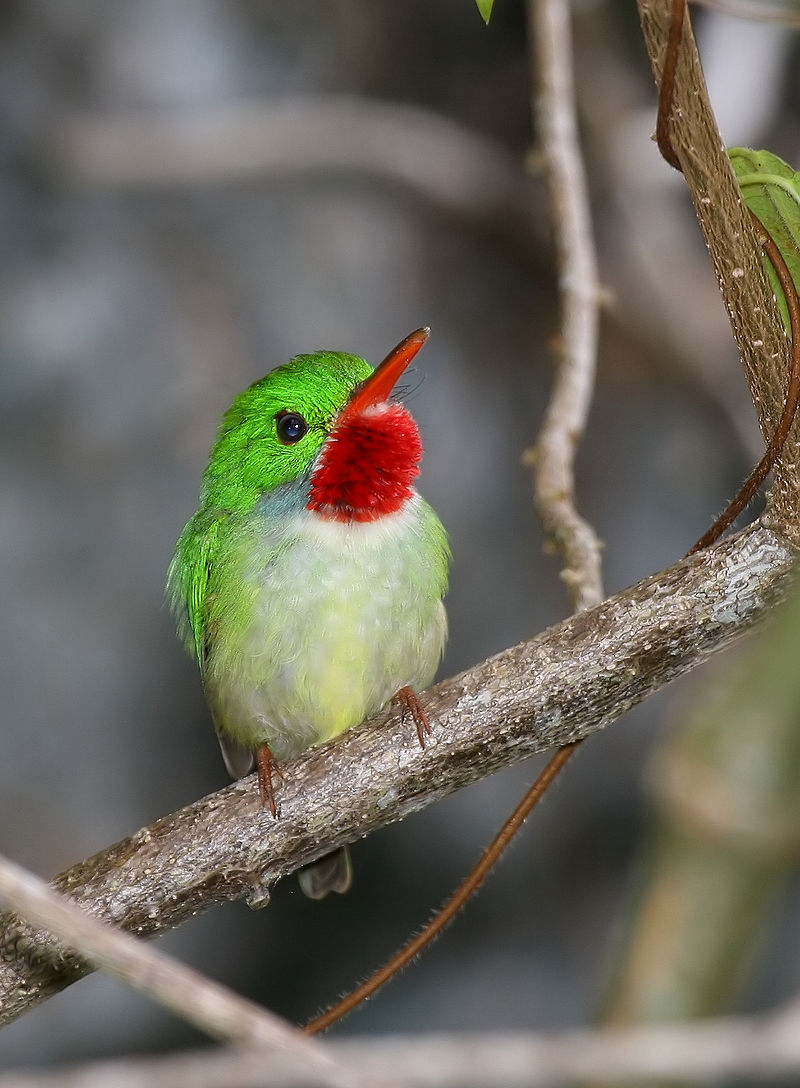
Todies are small birds found in the Caribbean. They are the only extant genus within the Todidae family. There are five species of todies, and they are mostly found in the forests of the Greater Antilles.
Each island within the region has at least one species of tody. Todies are considered near passerine birds, meaning they have similar characteristics to passerine birds like finches and sparrows. They have vibrant plumage and are known to be quite active.
The broad-billed tody is found in the lowlands of Hispaniola, including Gonâve Island. The tody is a unique species and makes for a delightful addition to the Caribbean wildlife.Scientific classification:
| Kingdom | Animalia |
| Phylum | Chordata |
| Class | Aves |
| Order | Coraciiformes |
| Family | Todidae |
| Genus | Todus Brisson, 1760 |
51. Waxwing Birds
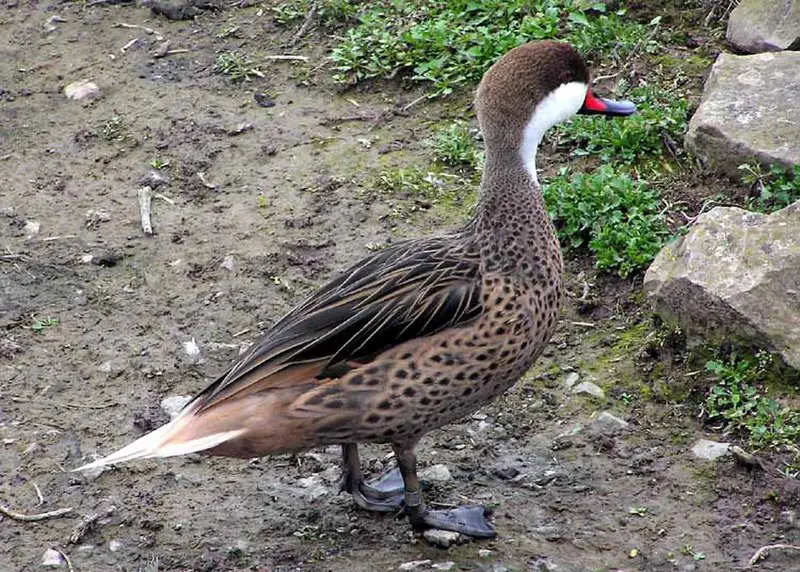
Waxwing birds are small to medium-sized birds with distinctive plumage. They have soft, silky feathers in shades of brown, gray, and rust. Their most striking feature is their crest of feathers on top of their heads, which they can raise or lower depending on their mood.
Waxwings are known for their sociable behavior and often travel in large flocks. They feed mainly on fruit, but will also eat insects during the breeding season. Their name comes from the red tips of the secondary feathers on their wings.
Waxwings are a migratory species, breeding in North America and wintering in the southern United States, Mexico, and Central America.
Despite their beautiful appearance, they are not commonly kept as pets as they can be difficult to care for and require specific diets.